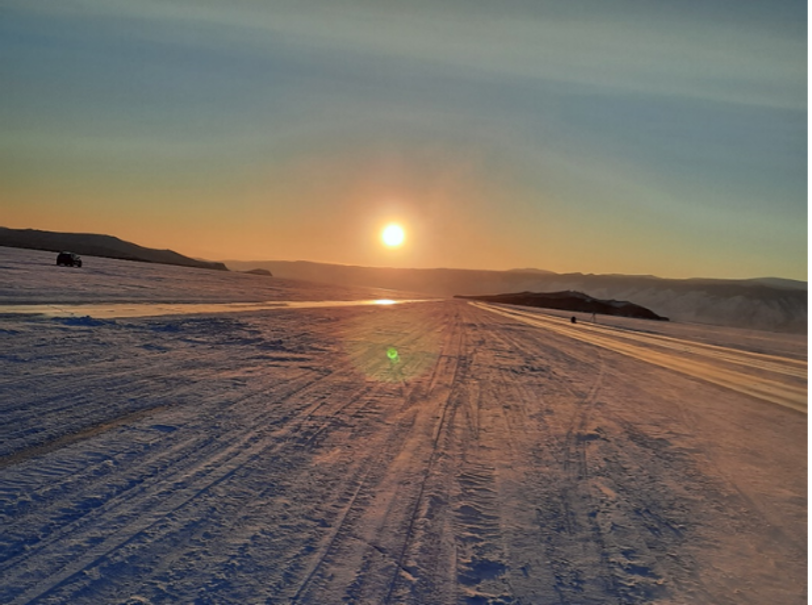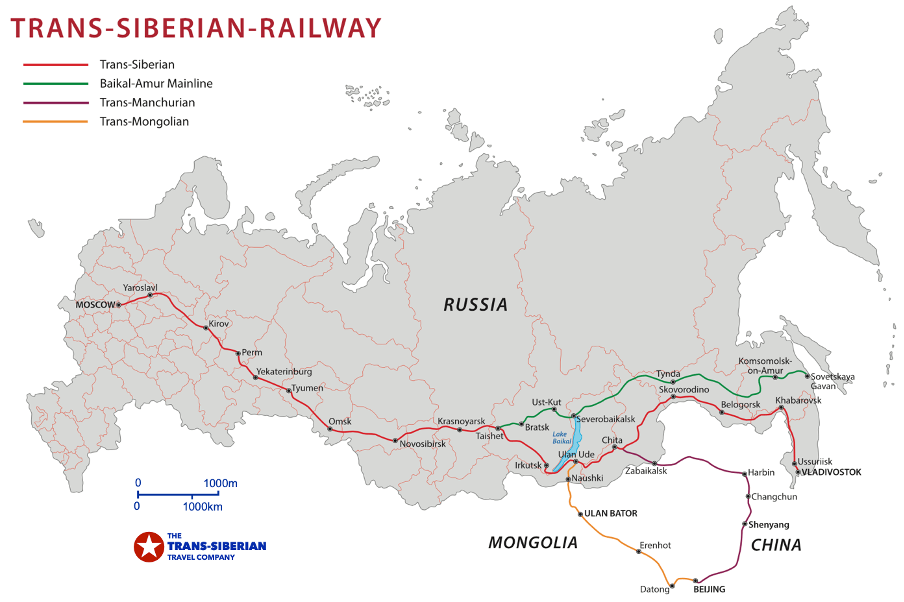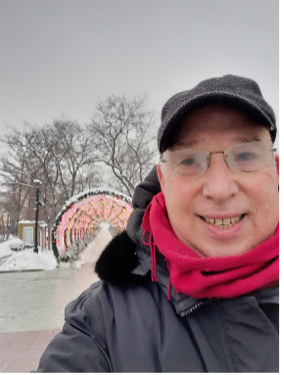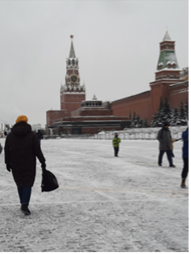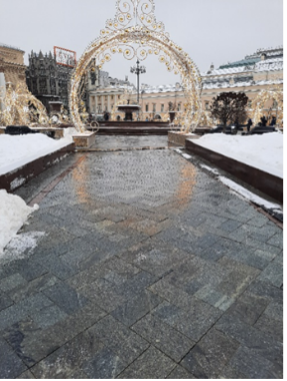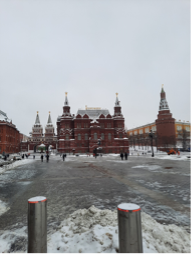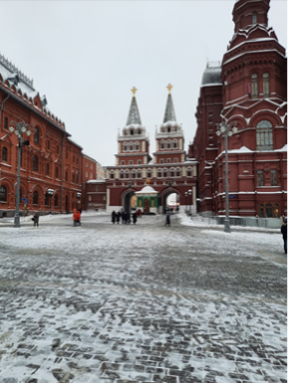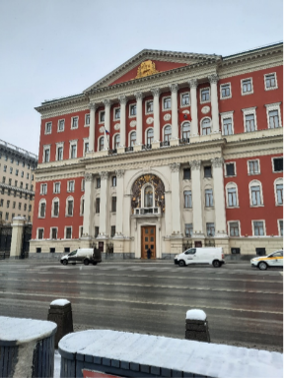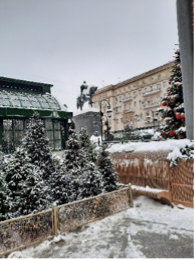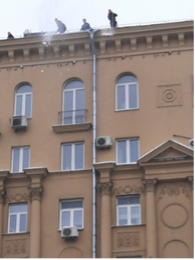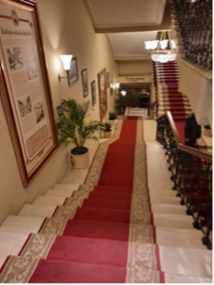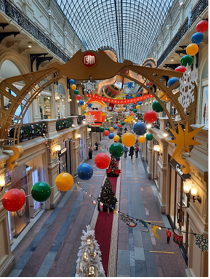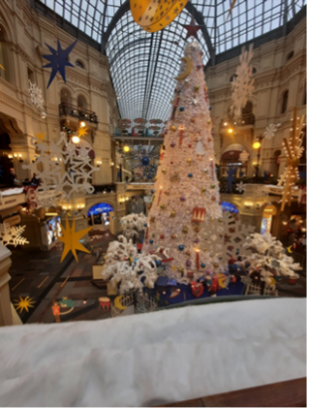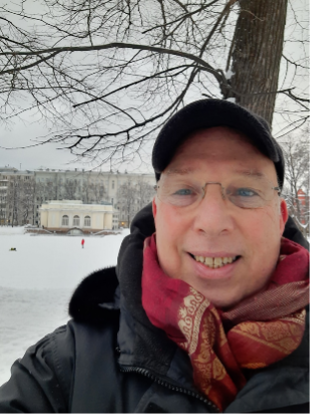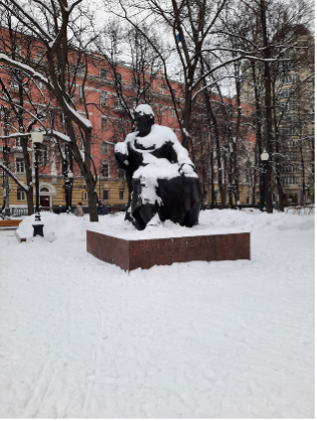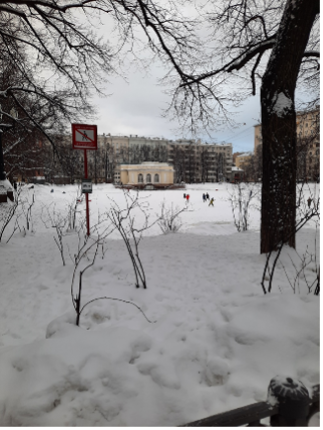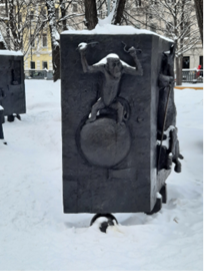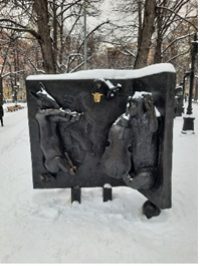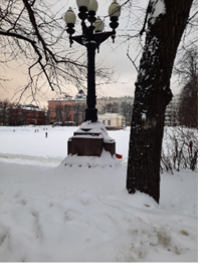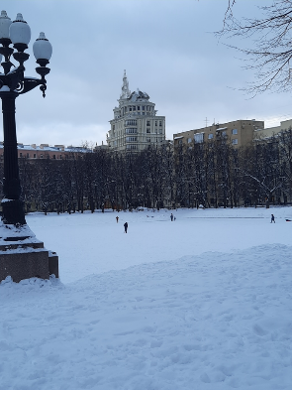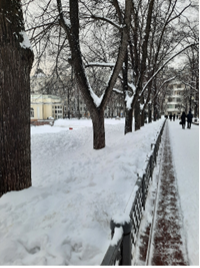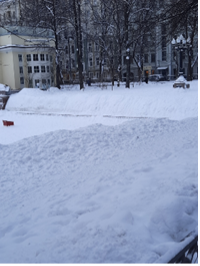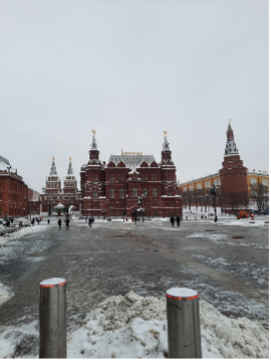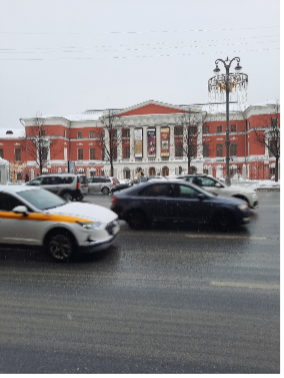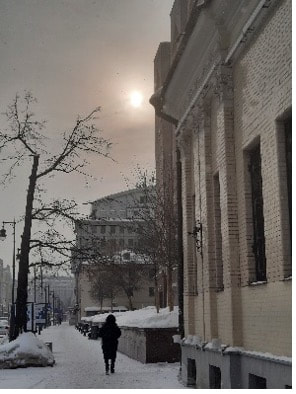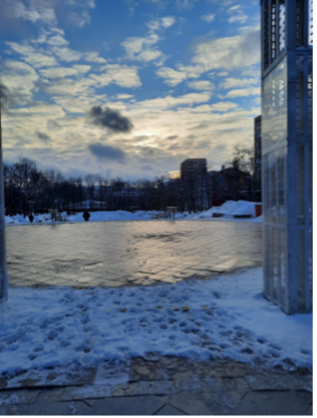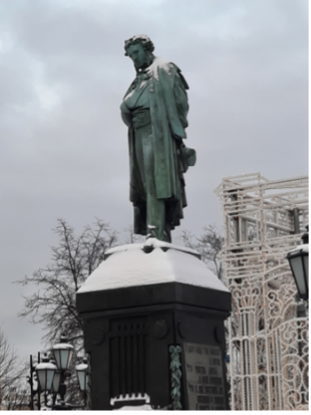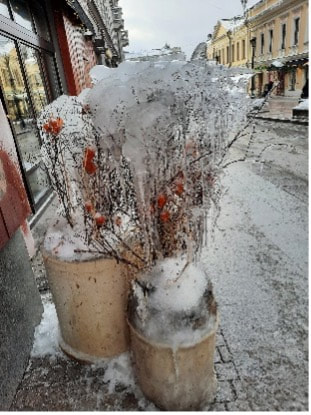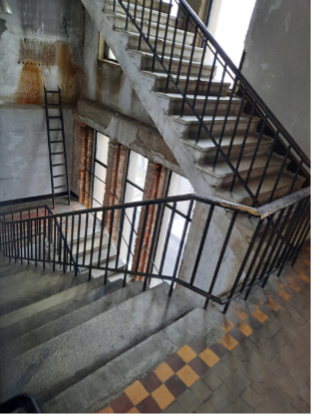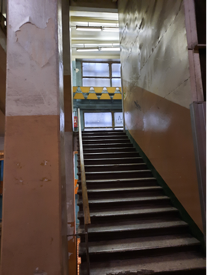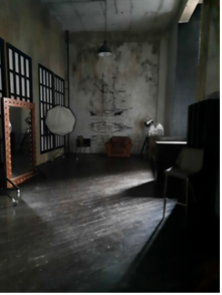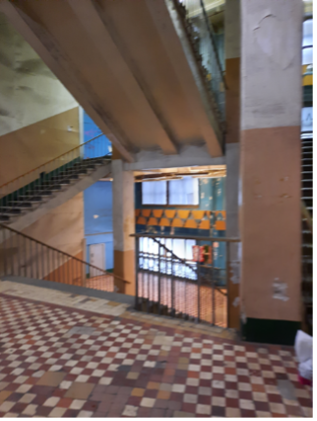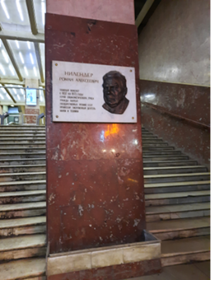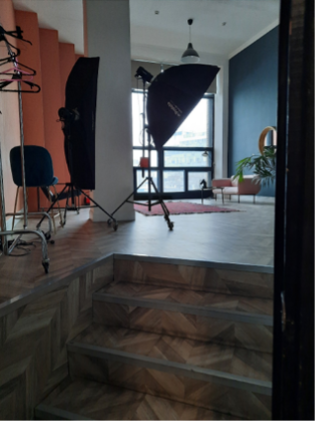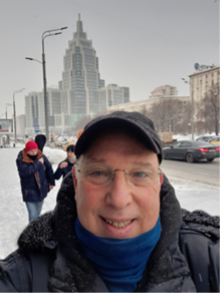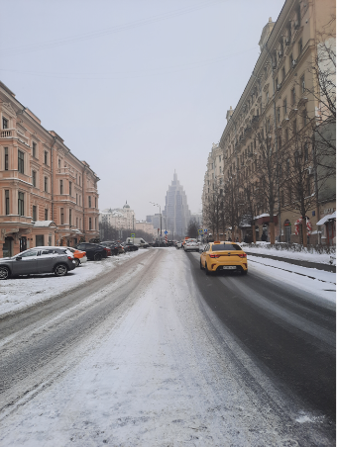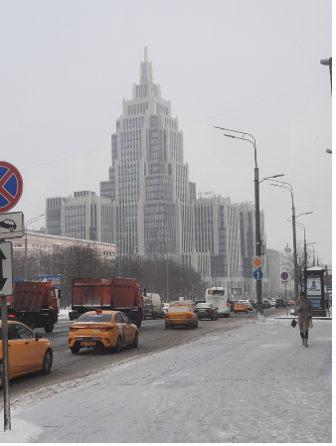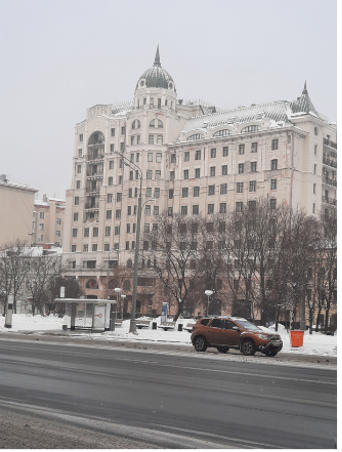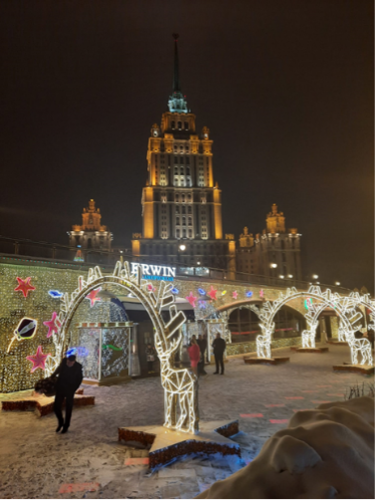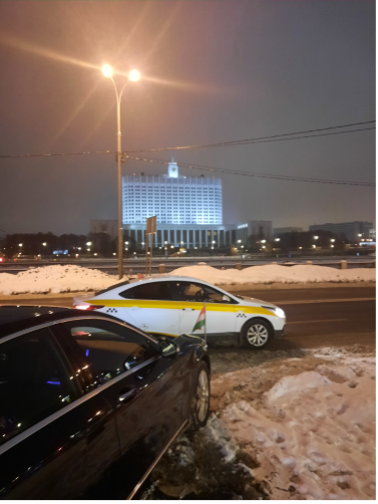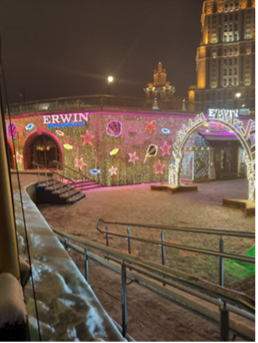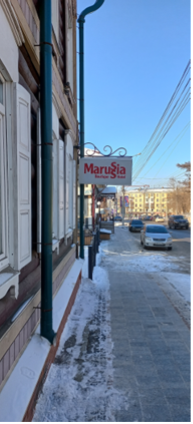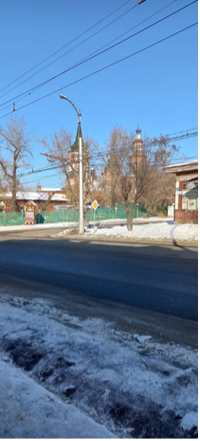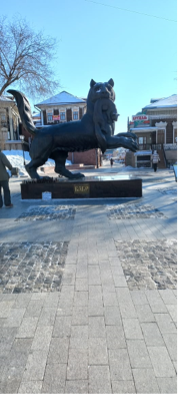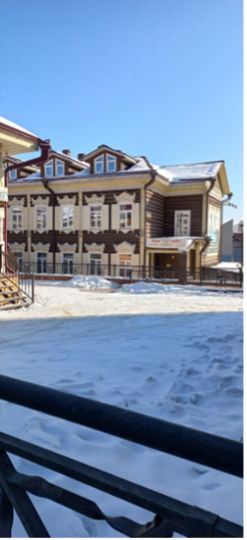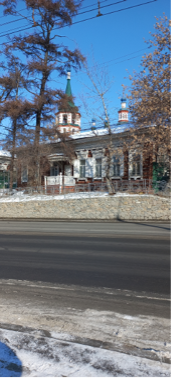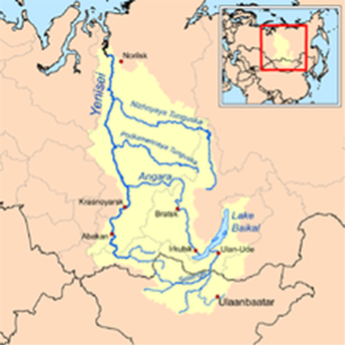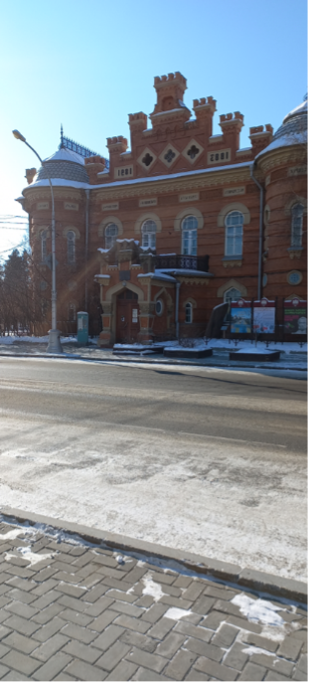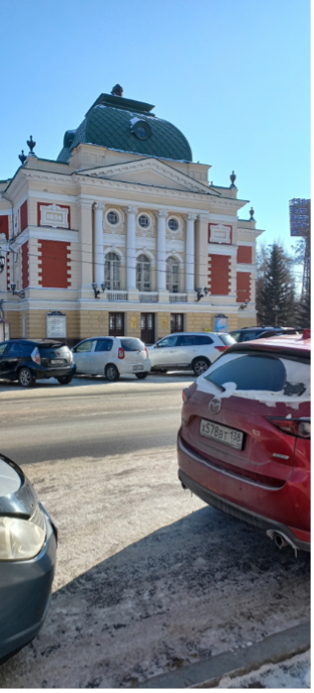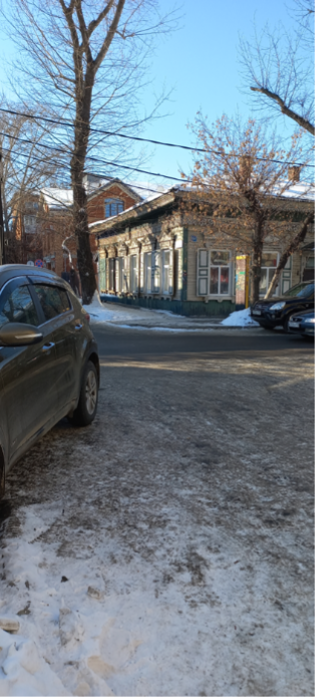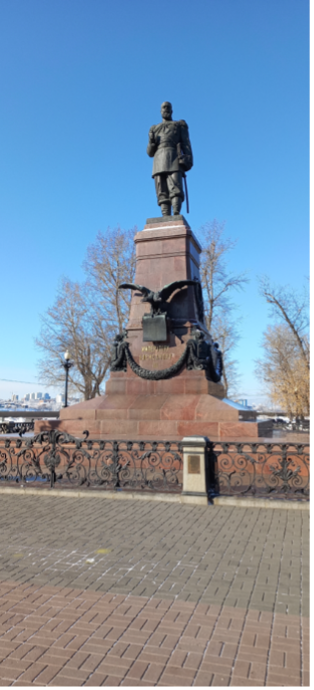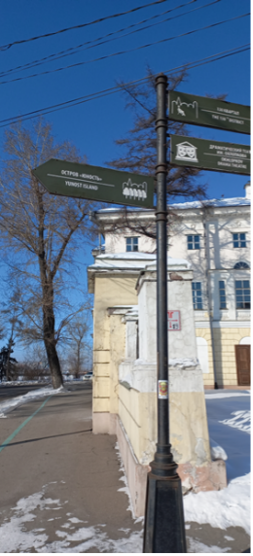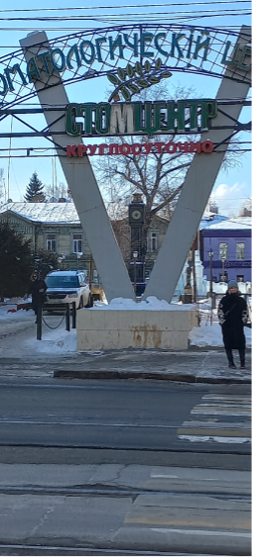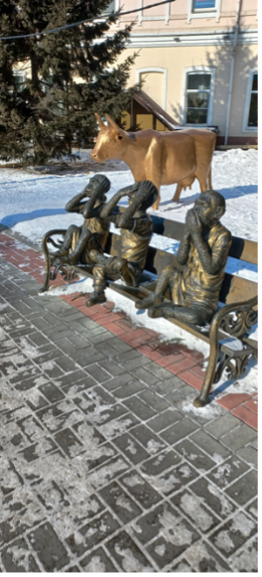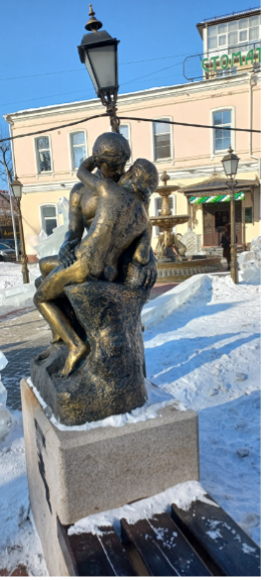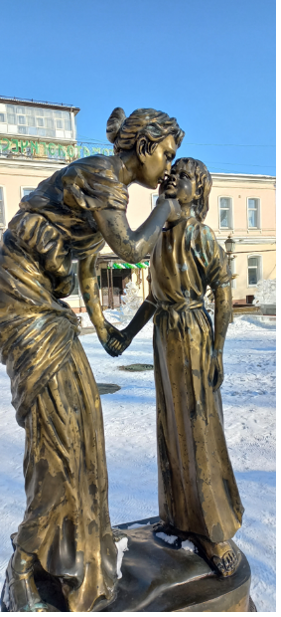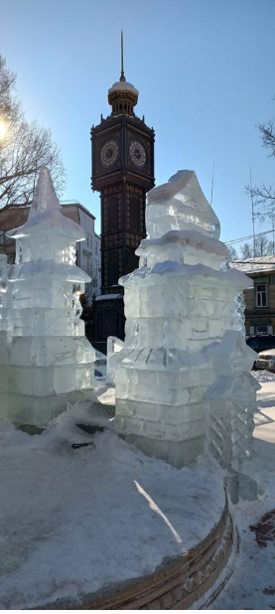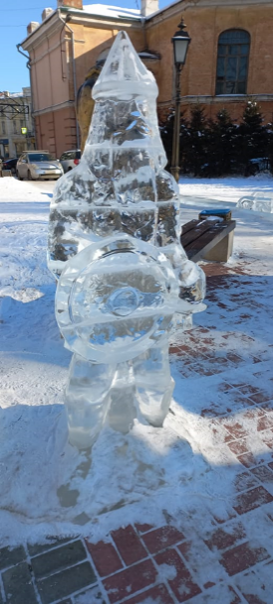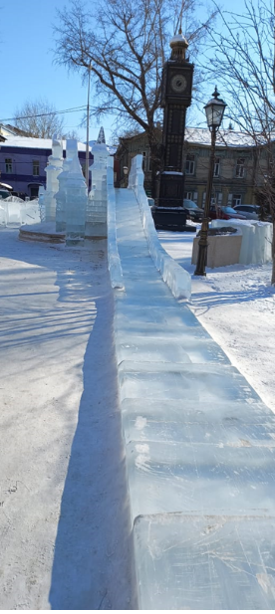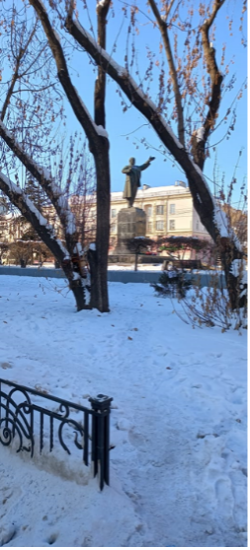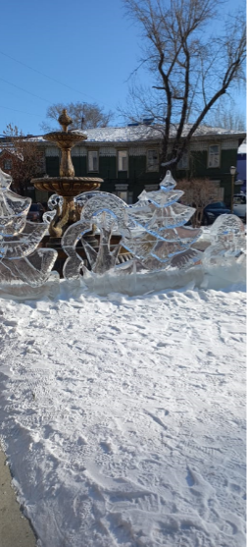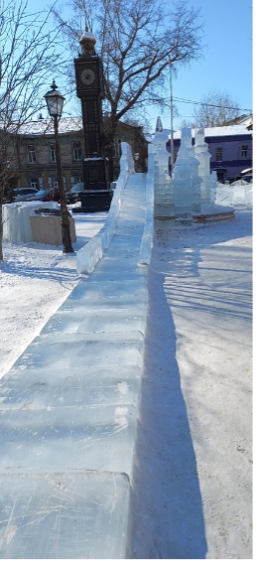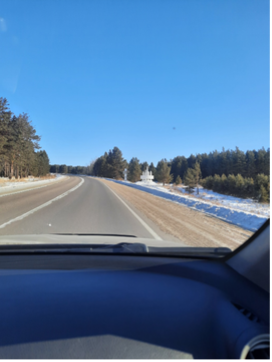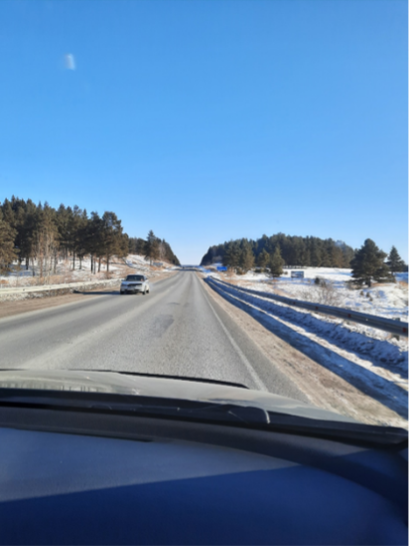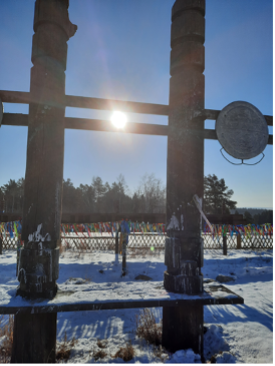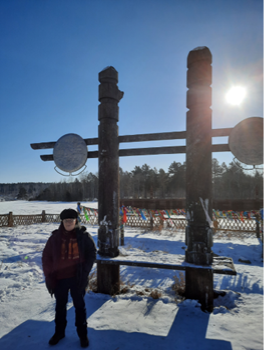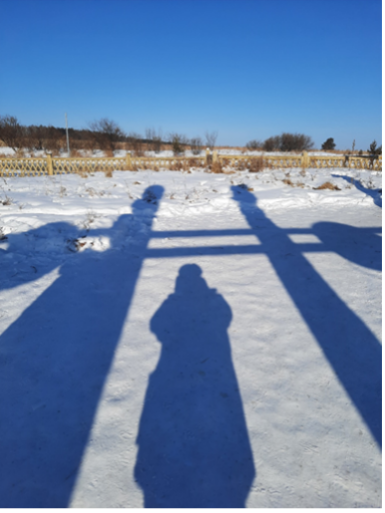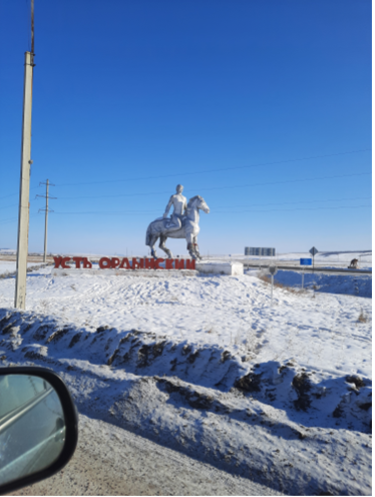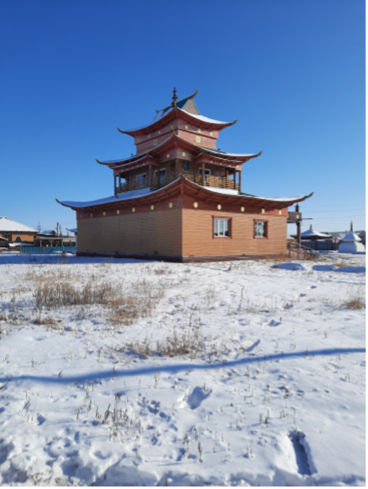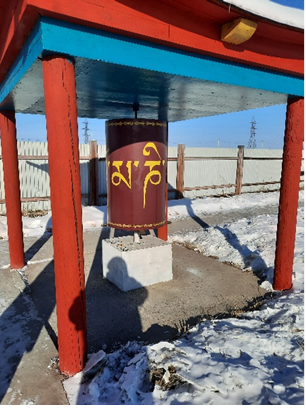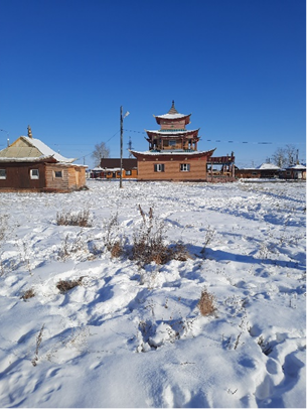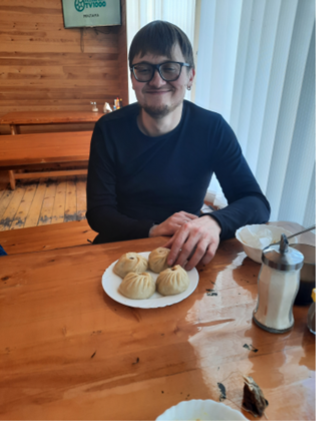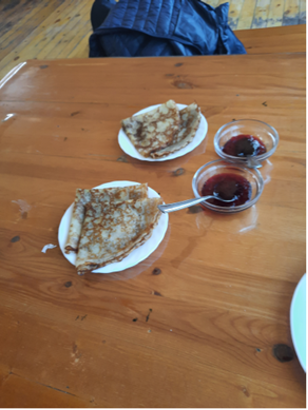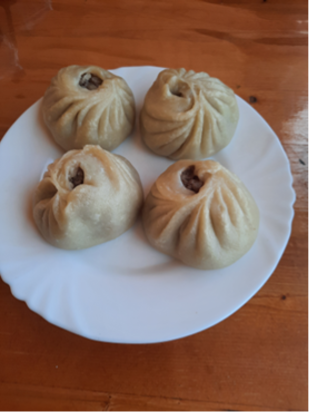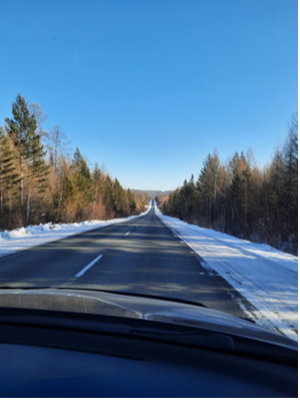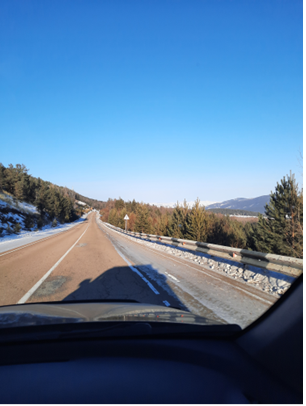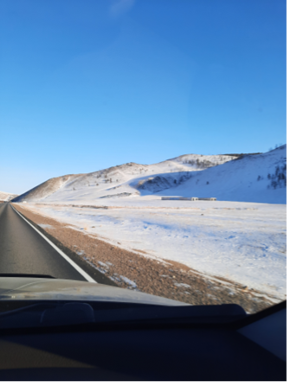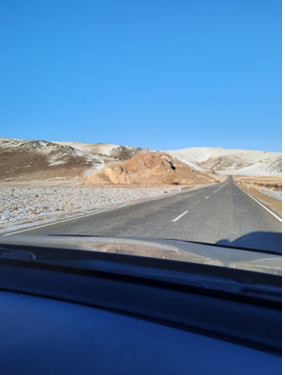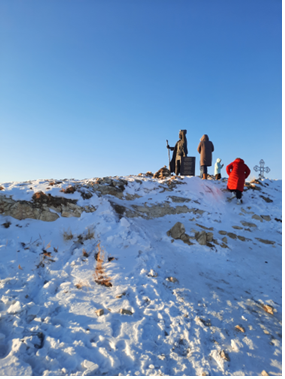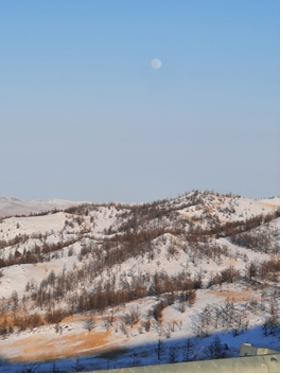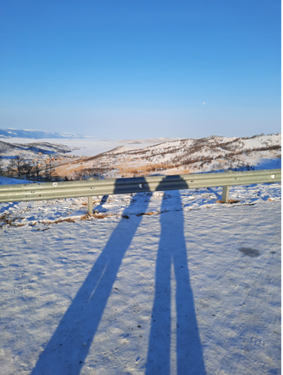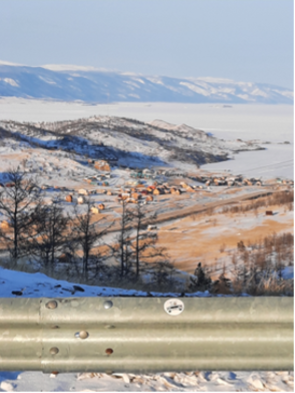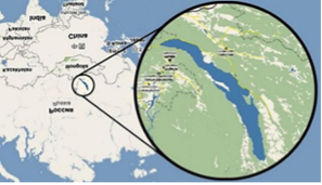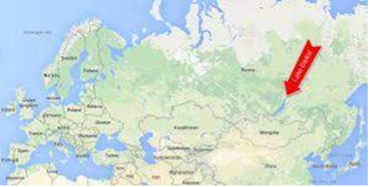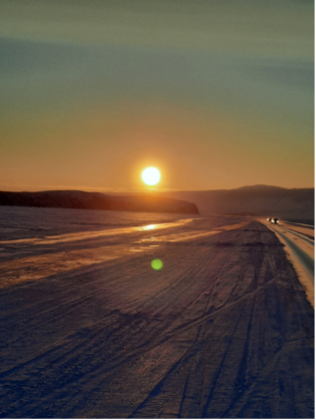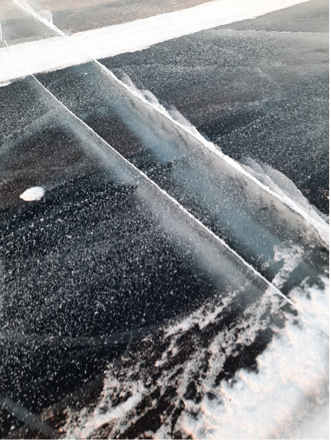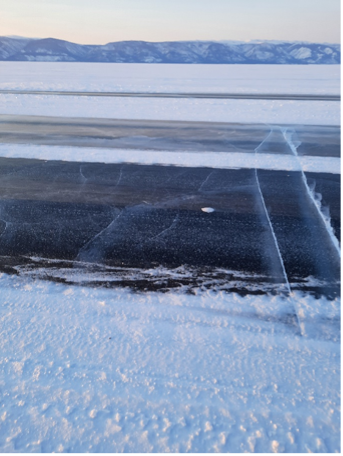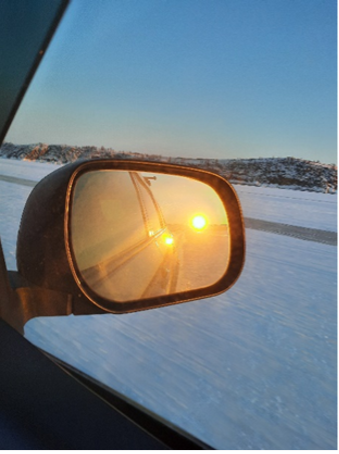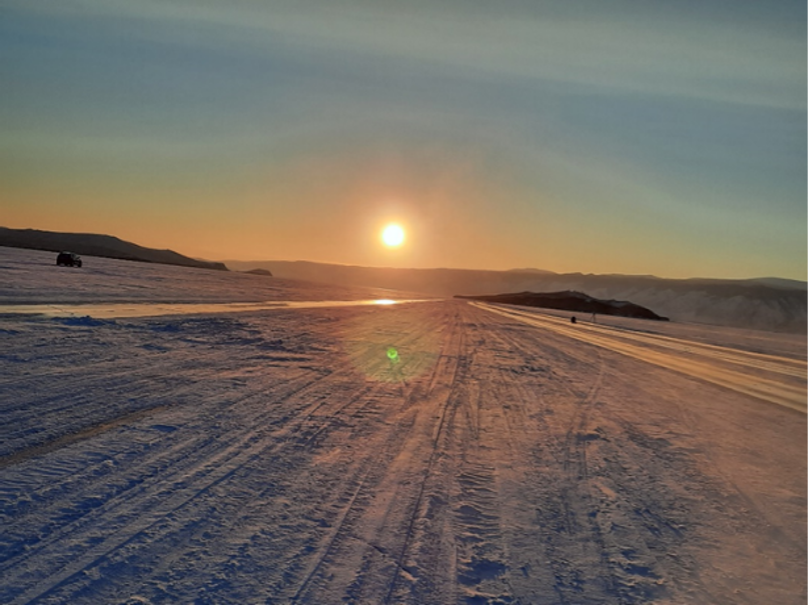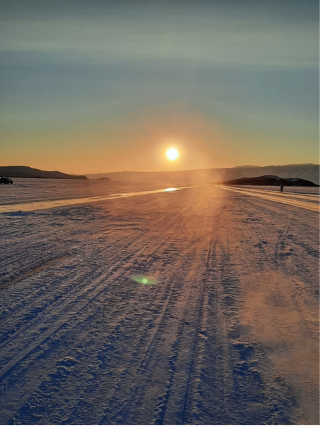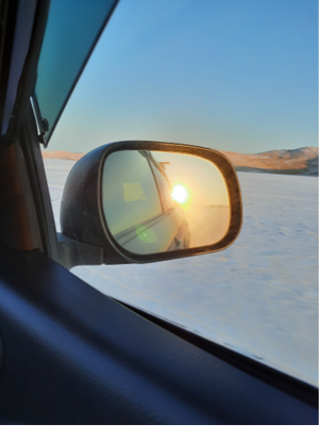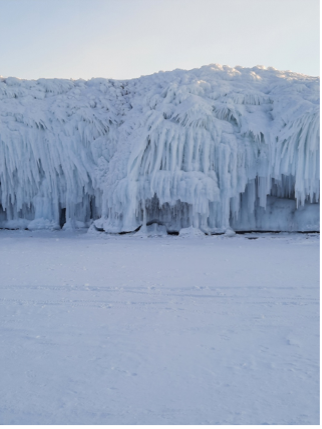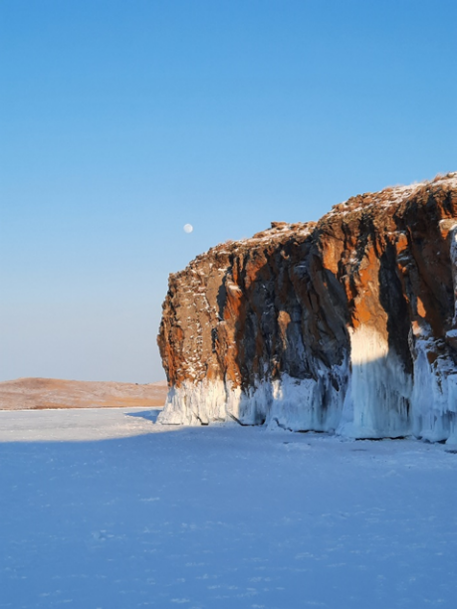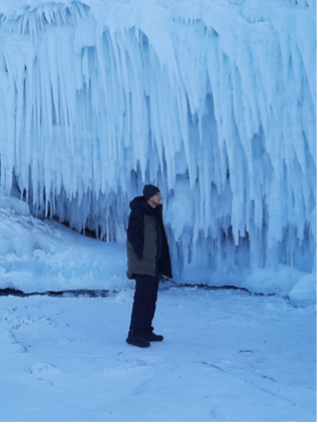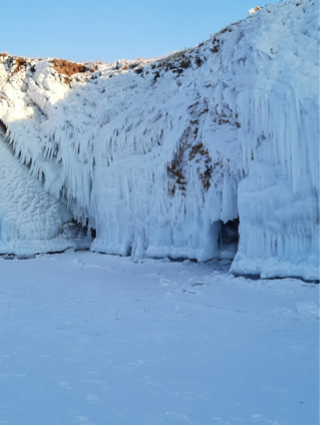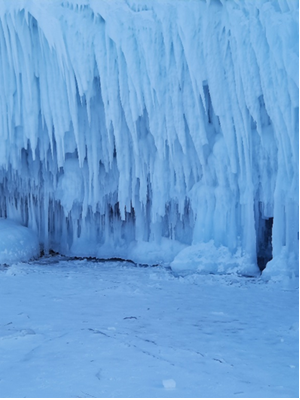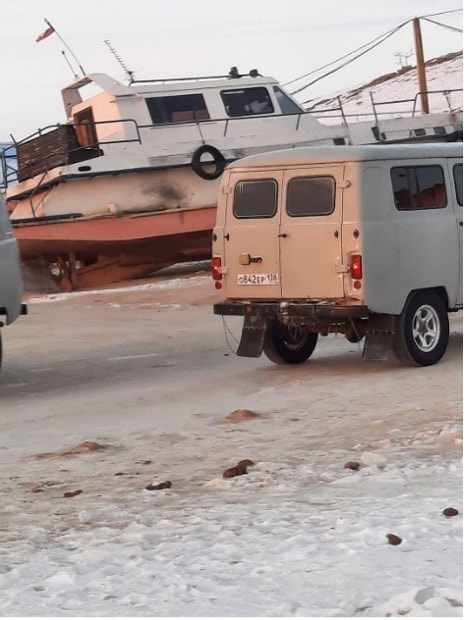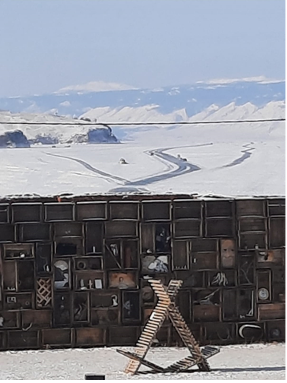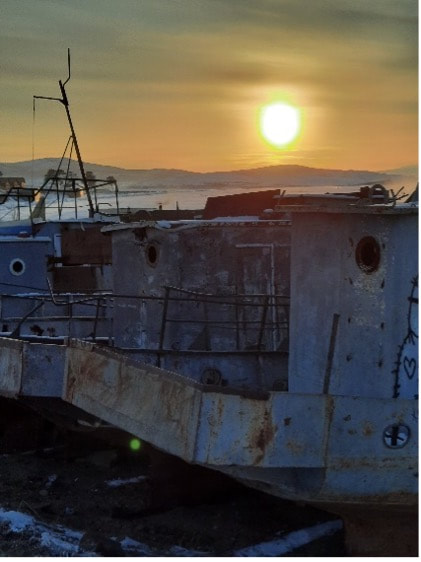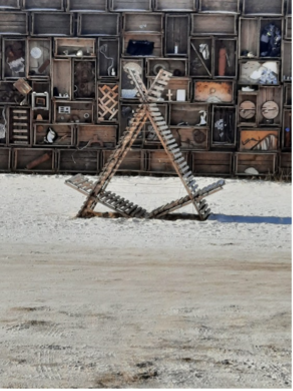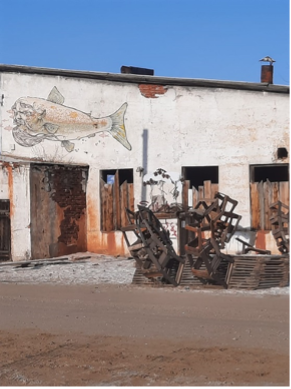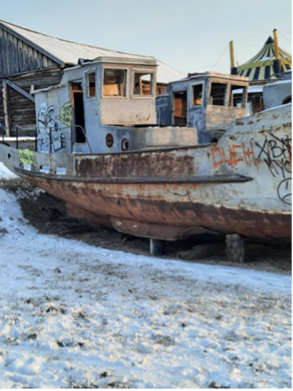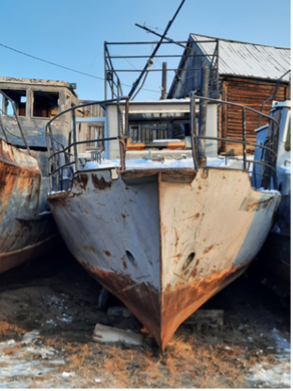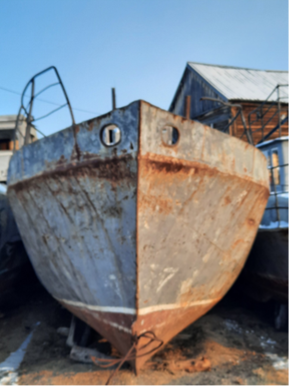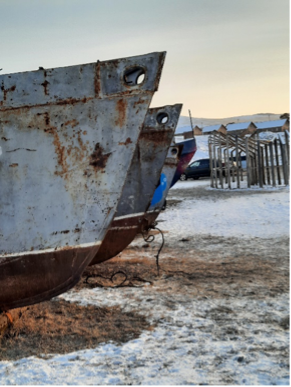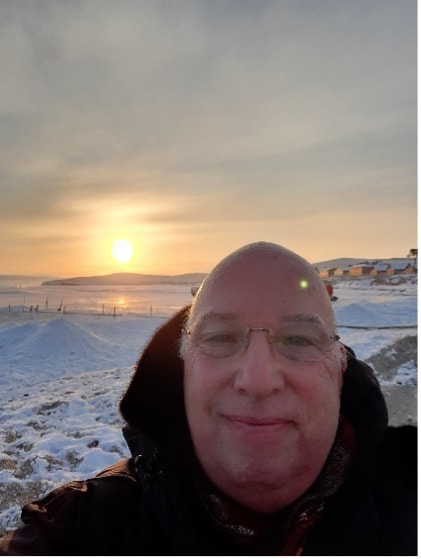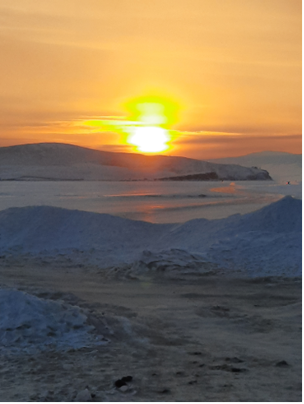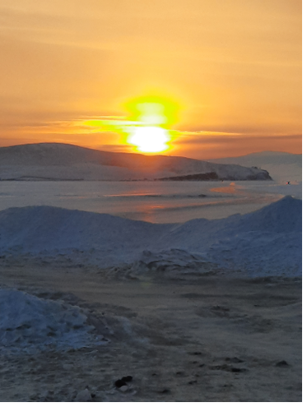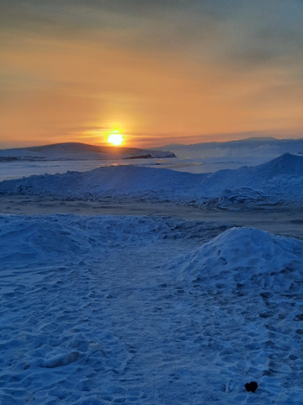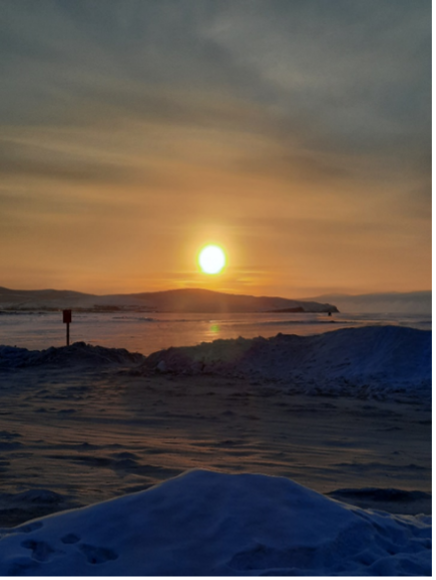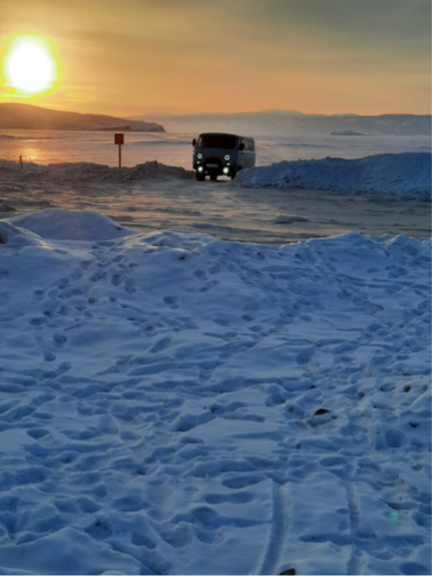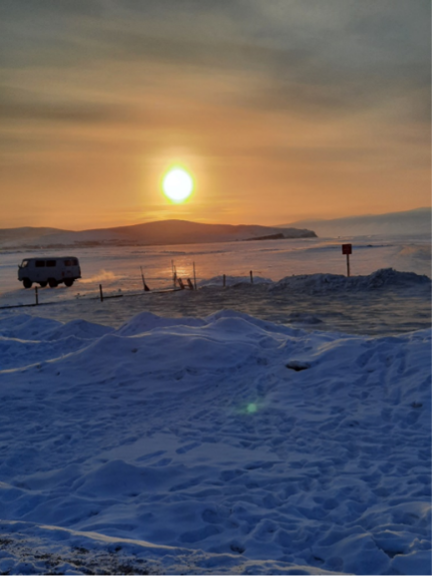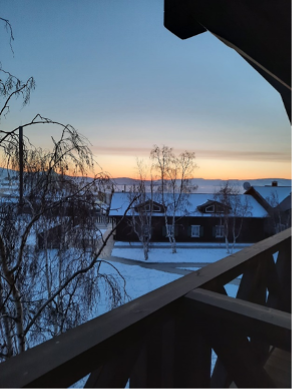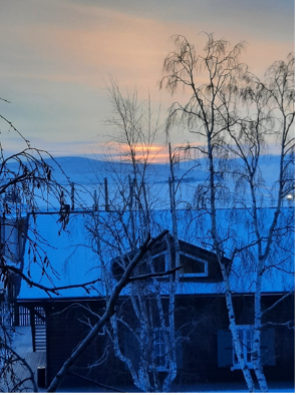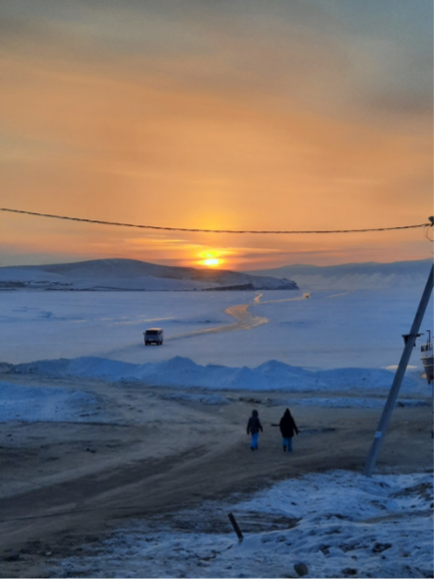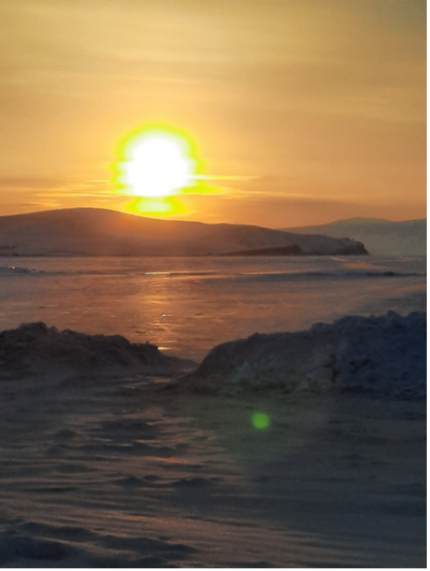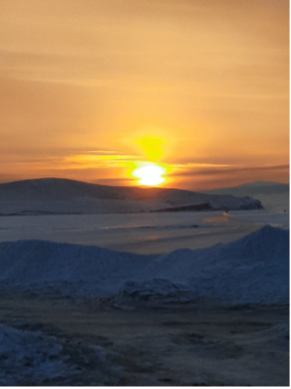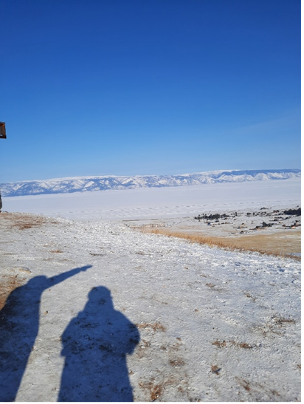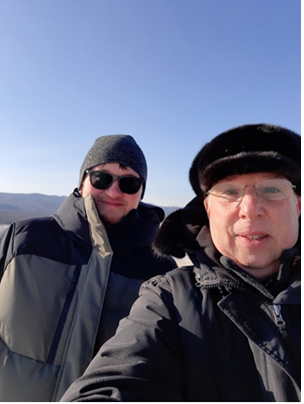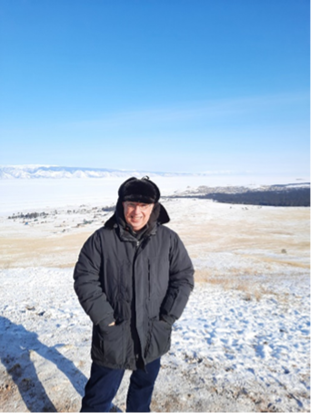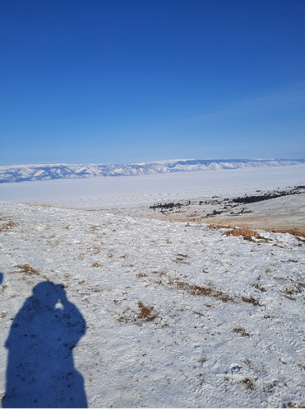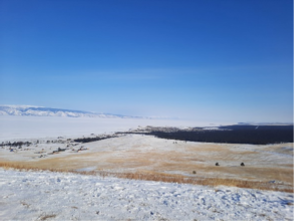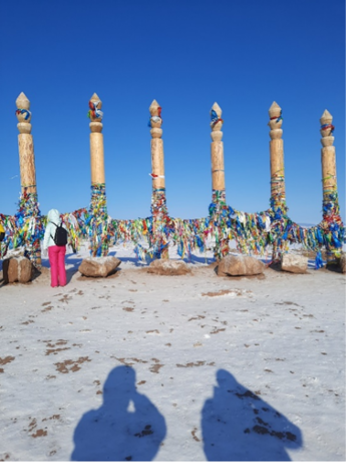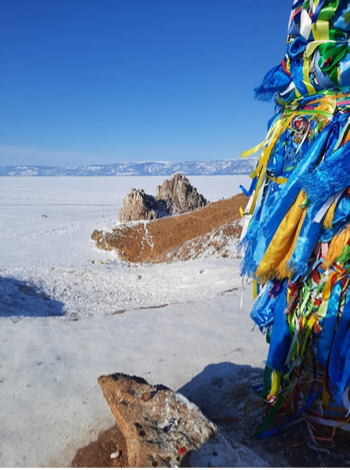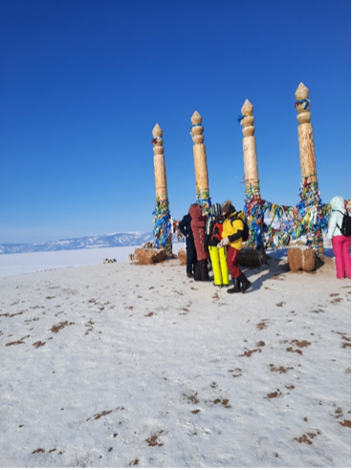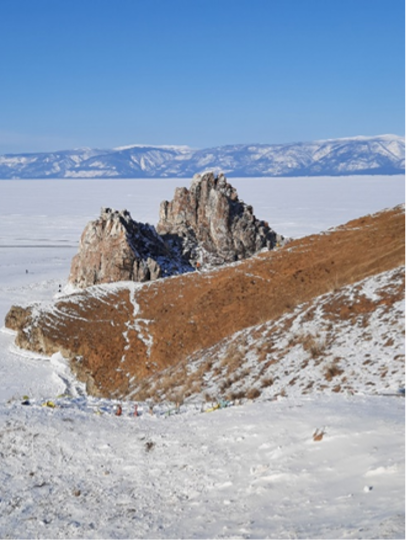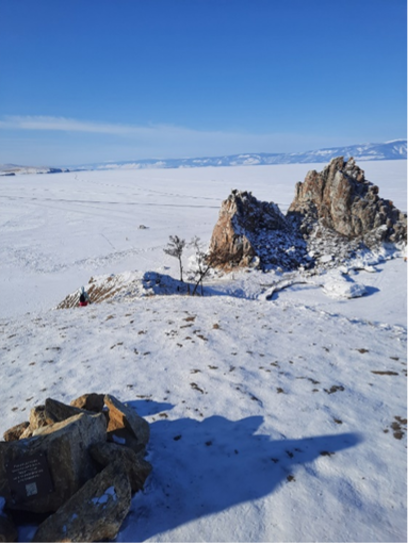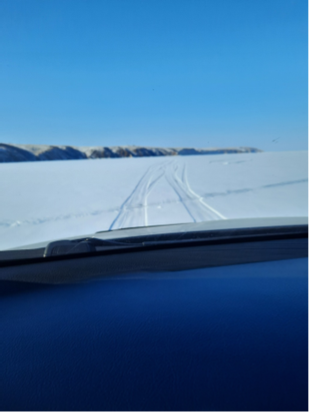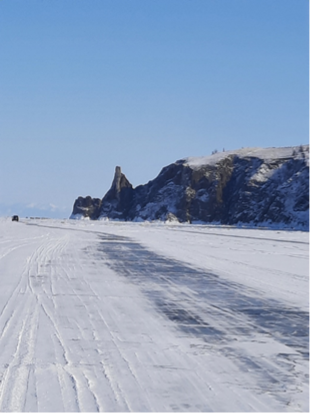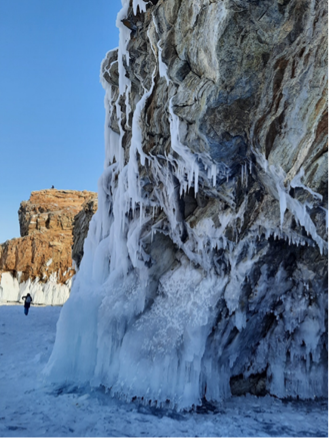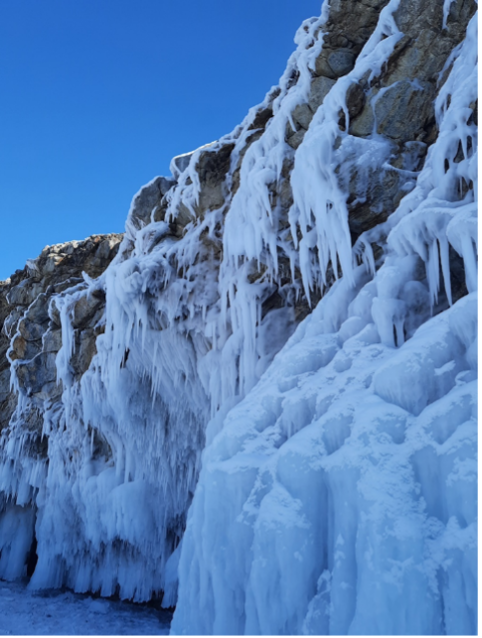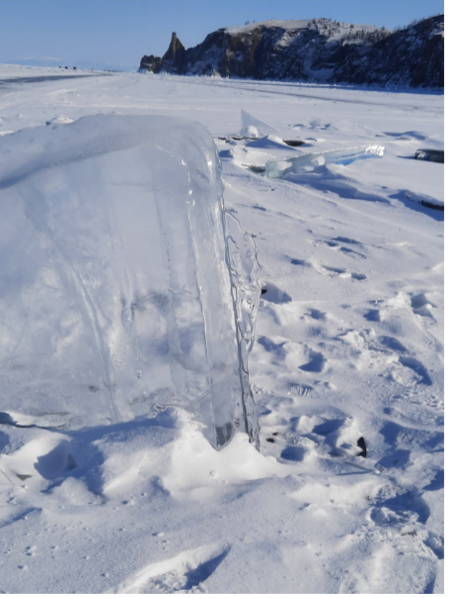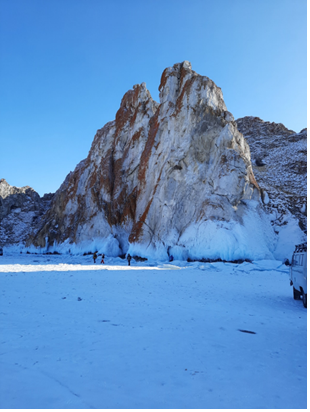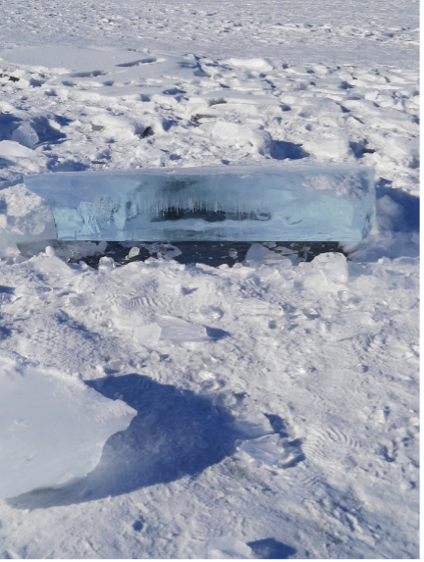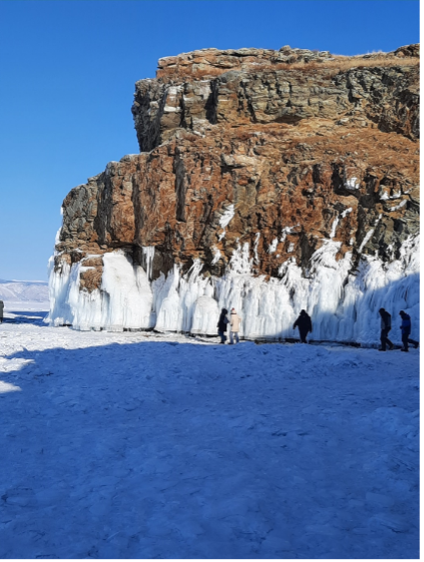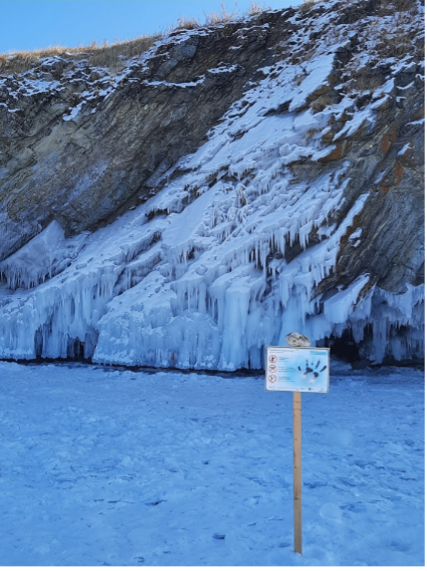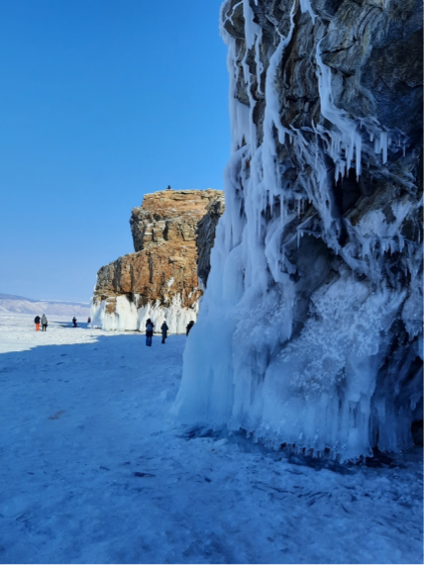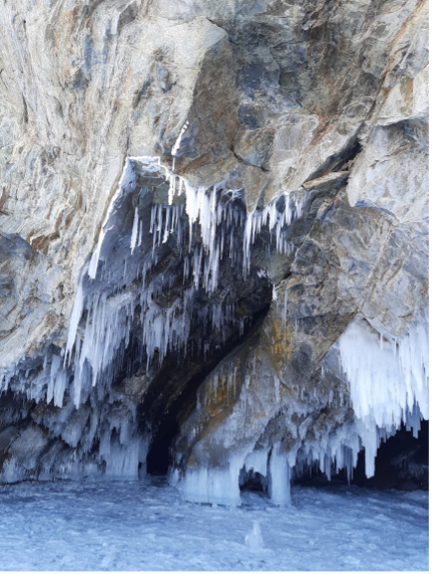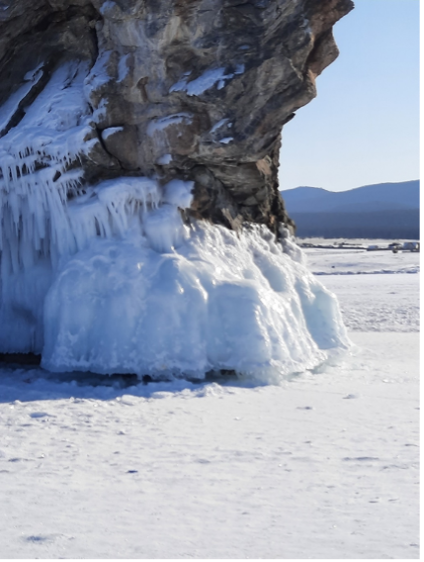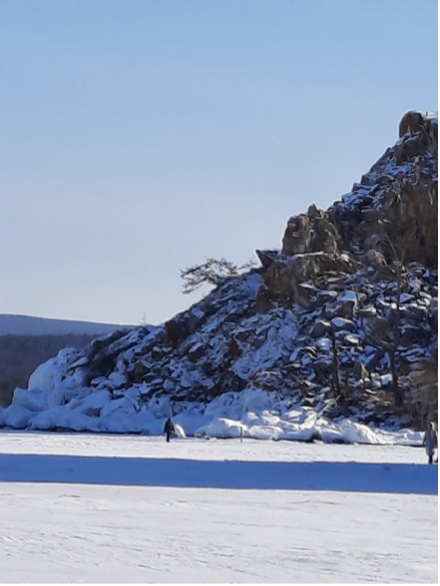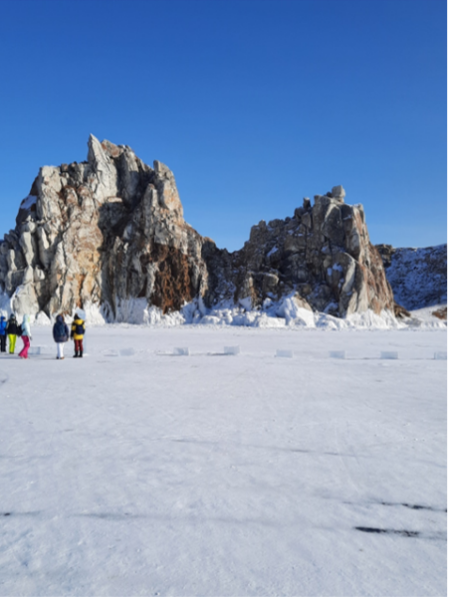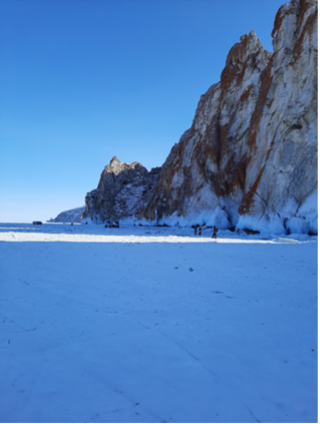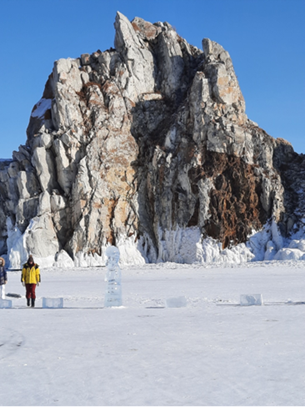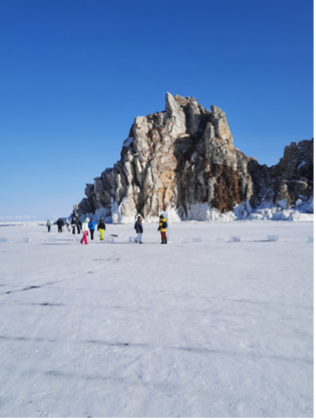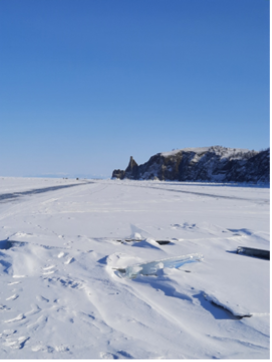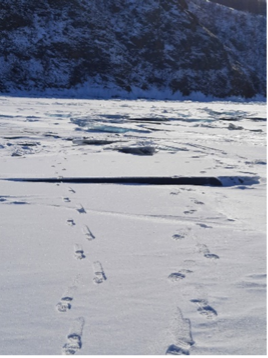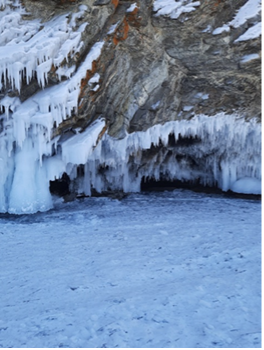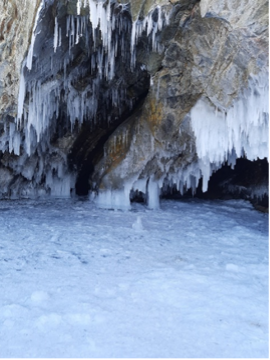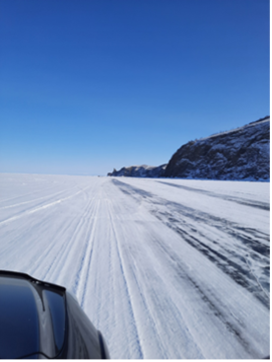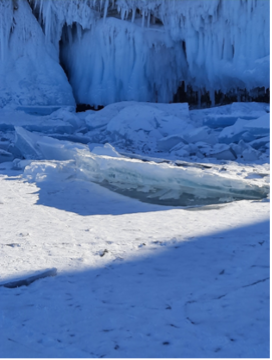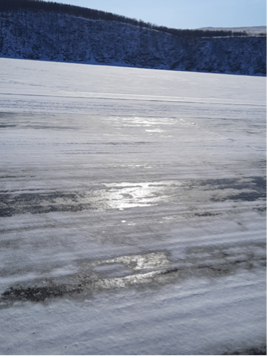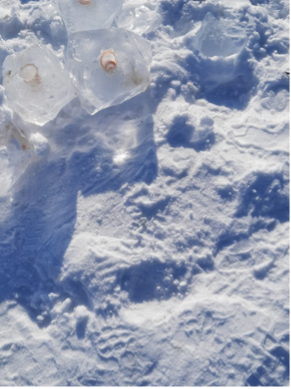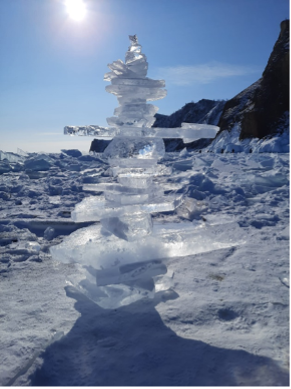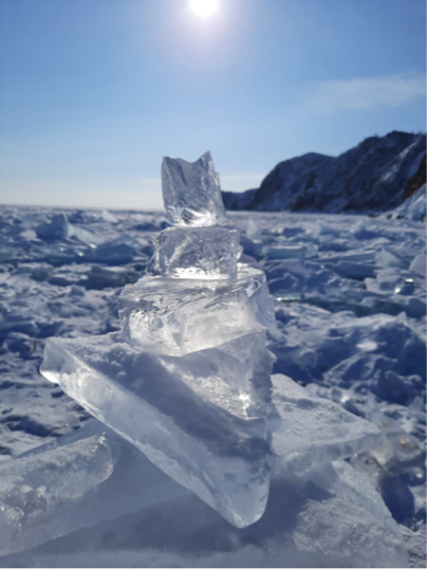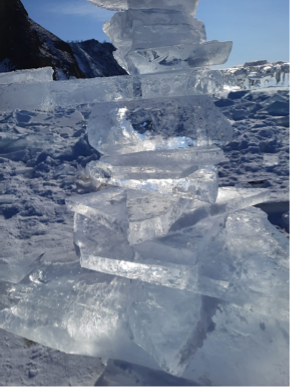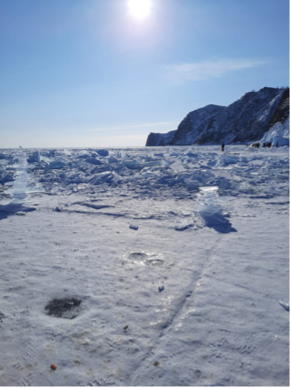This was my feeling from about October 2021 until I actually got on the plane. In retrospect it was a deep feeling based on my health and age but also, it was really profound bearing in mind what happened towards the end of February 2022 with the invasion of Ukraine. It shows that you never know about plans and life until you see things in retrospect. The trip was well planned but with Covid still present, when I was in Moscow, a number of the plans changed and due to the changes, I met some wonderful people and had really extraordinary experiences and cultural lessons.
One of my closest friends asked me why did I want to go, at that precise time and in the middle of winter? Good question but my answer was very simple “Because “. He looked at me quizzically and just said “but why”. My answer again simple was “because I wanted to, for many reasons some simple to understand, others more complex. Therefor my answer of “because “is a simple and all-encompassing answer. I hope the following diary will answer some of his (and other peoples) questions.
Introduction and background notes:
The Flight to Moscow:
28th January 2022
I checked in the for the flight early as always seat already reserved and visa checked and approved as well as the vaccination certificates. So, I was actually going on the flight or would things be cancelled at the last moment?
This was the first time since Covid since I had flown and I had forgotten so much, it was very surprising, but things came back to me very quickly. I walked through to the fast-track security lane, forgetting to take my computer out, empty my pockets and all the other things that used to be second nature to me. Thankfully it was very early and there were only a few people behind me. The security staff were patient and did not snigger too much. I was honestly embarrassed and angry at myself
I walked straight through security and then to the lounge for peace and quiet. I was still not really convinced that all would be ok but the adventure had started and I was beginning to think that all would be ok and then trying to prepare myself for the arrival process once in Moscow. Looking out of the window of the lounge the red sky and I was hopeful that the old message of “ red sky in the morning ..shepherd’s warning” was not true in my case .
I decided that for my trip it was a good omen, I hoped.
I checked in the for the flight early as always seat already reserved and visa checked and approved as well as the vaccination certificates. So, I was actually going on the flight or would things be cancelled at the last moment?
This was the first time since Covid since I had flown and I had forgotten so much, it was very surprising, but things came back to me very quickly. I walked through to the fast-track security lane, forgetting to take my computer out, empty my pockets and all the other things that used to be second nature to me. Thankfully it was very early and there were only a few people behind me. The security staff were patient and did not snigger too much. I was honestly embarrassed and angry at myself
I walked straight through security and then to the lounge for peace and quiet. I was still not really convinced that all would be ok but the adventure had started and I was beginning to think that all would be ok and then trying to prepare myself for the arrival process once in Moscow. Looking out of the window of the lounge the red sky and I was hopeful that the old message of “ red sky in the morning ..shepherd’s warning” was not true in my case .
I decided that for my trip it was a good omen, I hoped.
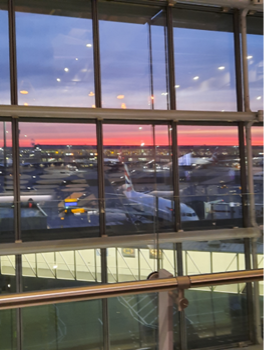
I found a good seat close to the bar and quietly read the paper, drank tea and people watched. In the past there were lots of Russians around for the flight. But this time there were only a few Russians (most of whom were going skiing apparently). It would be interesting to see how many people would be on the plane.
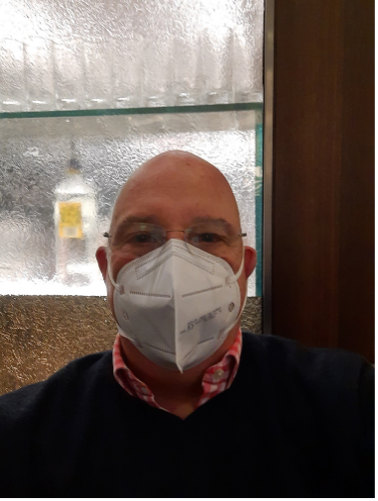
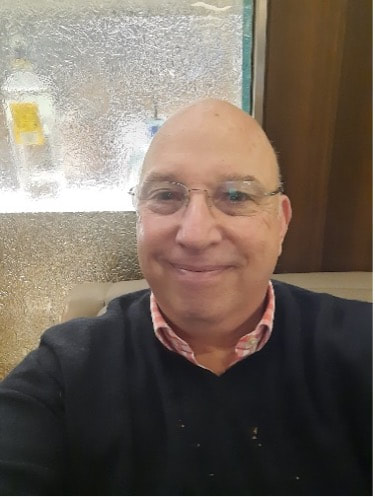
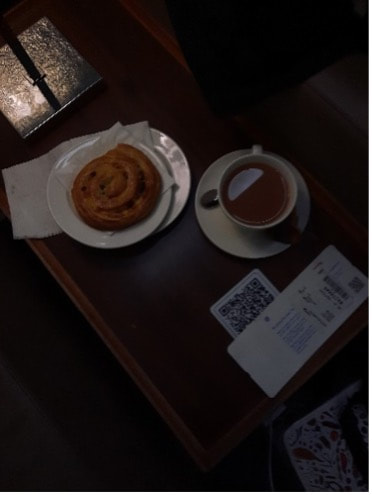
The flight was relatively, smooth, on time and uneventful, it was very empty, peaceful and quiet, which was perfect. I had plenty of time to rest, reflect and prepare myself for the normal chaos that I had always experienced in the past in passport control and then customs. Of course, I had forgotten that Covid was still serious around the world (especially in Russia) and that people had not travelled for a long time. Russia had only just opened to vaccinated tourists and as the Covid rates were still very high in Russia. Of course, in terms of Russia itself, in addition to Covid, people were still not prepared to travel to Moscow with the concern about the looming crisis and possible war in Ukraine.
The plane avoided Ukraine and the areas of possible conflict but the closer we flew to Moscow; it was clear that winter was in full flow and that as expected it would be very cold in Moscow with heavy snow on the ground.
The plane avoided Ukraine and the areas of possible conflict but the closer we flew to Moscow; it was clear that winter was in full flow and that as expected it would be very cold in Moscow with heavy snow on the ground.
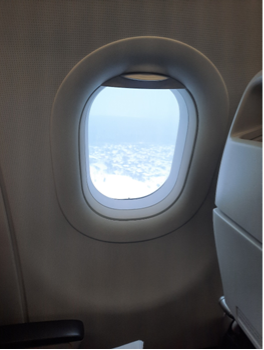
On arrival there was a new procedure, temperature scans firstly as a medical team walked through the cabins fully masked and gowned up, and then disembarkation by row, being on the second row and no one was in front of me, I was one of the first to exit the flight. No obvious additional security and I was shocked that the passport section was empty (in the past it often took up to an hour to pass through passport control). I was also even more surprised that they were very relaxed and just took my entry forms, scanned my visa and then very politely (and almost smiling) waved me through without any delays or dour faces as in the past. Unbelievable change from the past.
Then prior to baggage claim there was a Covid PCR test section which checked my certificates with a cursory glance and then I was separated from the Russians who had just to do a lateral flow test. I was told that prior to leaving on the train journey there would be a need for 2 additional tests within the 8 days but that it could be done close to the hotel and the results would be sent to the Ministry and if it was positive, they would contact me in the hotel but could isolate there. Very reassuring. I was free in the meantime to wander around without any restrictions. Rules in restaurants and public areas had to be followed (masks etc.), but nothing onerous or restrictive (apart from museums where there was a need for QR codes which were not available for foreigners as far as I was told.
My luggage was collected from the conveyor belt and then it was through to the customs section, whose inspectors looked very bored as there were not many incoming flights to handle. To keep busy they made everyone to scan the luggage and finally it was out to meet the driver and to the hotel. Very straight forward painless and civilised. The first time in over 20 years.
Then prior to baggage claim there was a Covid PCR test section which checked my certificates with a cursory glance and then I was separated from the Russians who had just to do a lateral flow test. I was told that prior to leaving on the train journey there would be a need for 2 additional tests within the 8 days but that it could be done close to the hotel and the results would be sent to the Ministry and if it was positive, they would contact me in the hotel but could isolate there. Very reassuring. I was free in the meantime to wander around without any restrictions. Rules in restaurants and public areas had to be followed (masks etc.), but nothing onerous or restrictive (apart from museums where there was a need for QR codes which were not available for foreigners as far as I was told.
My luggage was collected from the conveyor belt and then it was through to the customs section, whose inspectors looked very bored as there were not many incoming flights to handle. To keep busy they made everyone to scan the luggage and finally it was out to meet the driver and to the hotel. Very straight forward painless and civilised. The first time in over 20 years.
The Trans Siberia Line itself; A brief introduction
The railway is often associated with the main transcontinental Russian line that connects hundreds of large and small cities of the European and Asian parts of Russia. Moscow–Vladivostok distance is 9,289 kilometres (5,772 miles) and it spans a eight time zones. Taking eight days to complete the journey without stopping and going on side trips, it is the third-longest single continuous service in the world.
I followed the commonly used main line route firstly using the Rossiya 002 train to Yekaterinburg and then on the 062 as far as Vladivostok.
And so it began “Michael to Baikal”
I followed the commonly used main line route firstly using the Rossiya 002 train to Yekaterinburg and then on the 062 as far as Vladivostok.
And so it began “Michael to Baikal”
Moscow:
The start of the trip properly, the first few nights on the train
Train from Moscow Rossiya 002 to Yekaterinburg
7th February 2022
Leaving the hotel for the Yaroslavsky train station was the real start of the trip, walking through the security screening, looking at the people waiting to board a number of long-distance trains and not certain of what to expect, I strode onto the main waiting area outside to wait for the train to arrive and then board. Oblivious to the cold, snow and ice I watched people rushing to catch trains, some rather drunk, missing trains and at least one man being dragged off a platform by security workers.
Train signs were in Russian and English and it was easy to understand the platform number and carriage position. It seemed an eternity waiting for the train in the cold and blowing snow but I did not want to wait in the station and risk missing the train (I can get distracted). It was also interesting to be honest to watch the world go by, the realise how busy the station was and also the types of people who travel by train.
On time the train arrived at platform 1 and the adventure was about the start. Walking to the platform there was a feeling of anticipation and also nervousness about the challenges I was about to meet in addition to the awareness that I am not Russian and unease about the number of police and security people in the station area. At least I was not standing out as a foreigner and also, I tried to blend in with the rest of the passengers.
7th February 2022
Leaving the hotel for the Yaroslavsky train station was the real start of the trip, walking through the security screening, looking at the people waiting to board a number of long-distance trains and not certain of what to expect, I strode onto the main waiting area outside to wait for the train to arrive and then board. Oblivious to the cold, snow and ice I watched people rushing to catch trains, some rather drunk, missing trains and at least one man being dragged off a platform by security workers.
Train signs were in Russian and English and it was easy to understand the platform number and carriage position. It seemed an eternity waiting for the train in the cold and blowing snow but I did not want to wait in the station and risk missing the train (I can get distracted). It was also interesting to be honest to watch the world go by, the realise how busy the station was and also the types of people who travel by train.
On time the train arrived at platform 1 and the adventure was about the start. Walking to the platform there was a feeling of anticipation and also nervousness about the challenges I was about to meet in addition to the awareness that I am not Russian and unease about the number of police and security people in the station area. At least I was not standing out as a foreigner and also, I tried to blend in with the rest of the passengers.
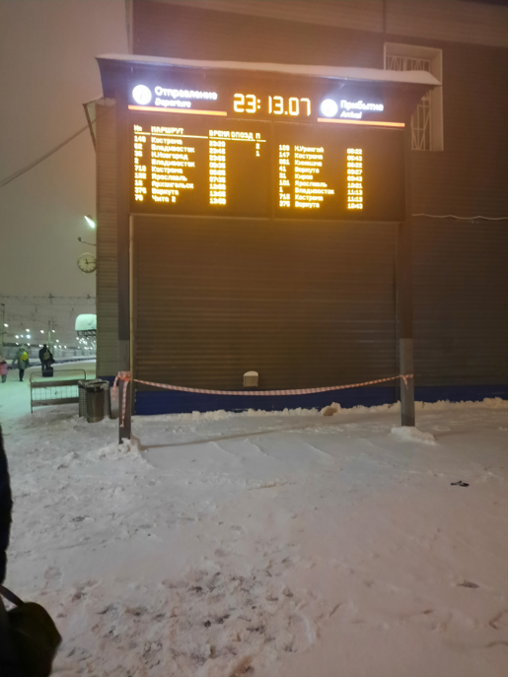
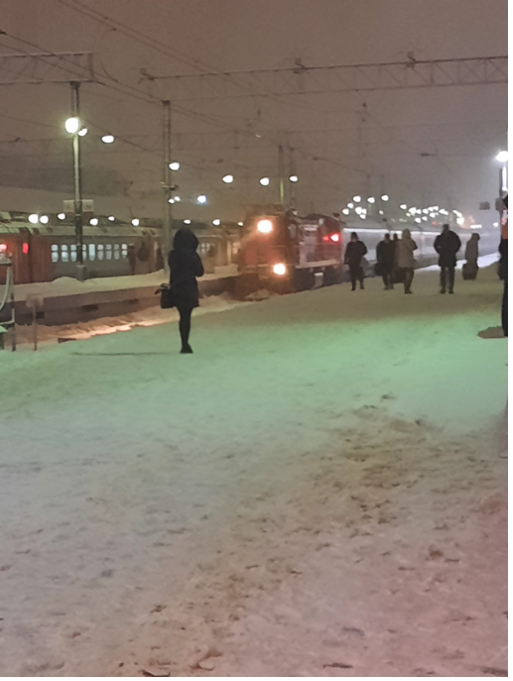
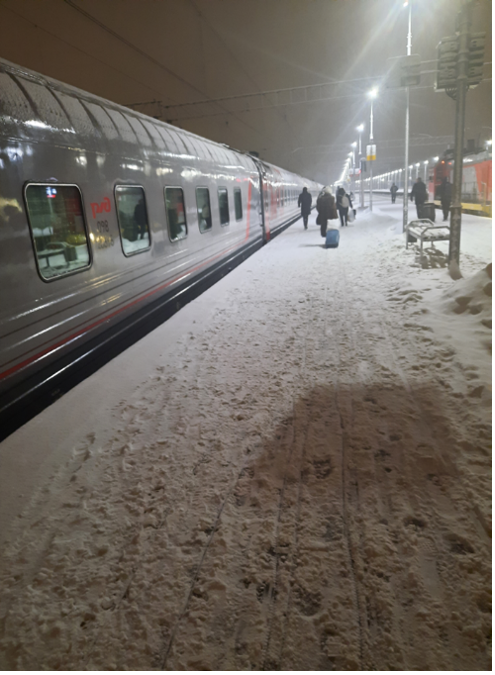
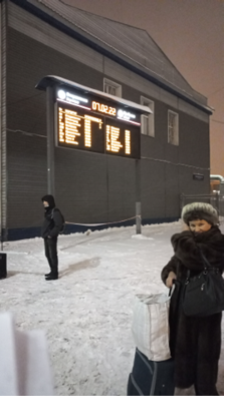
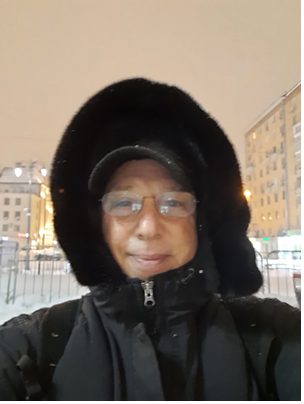
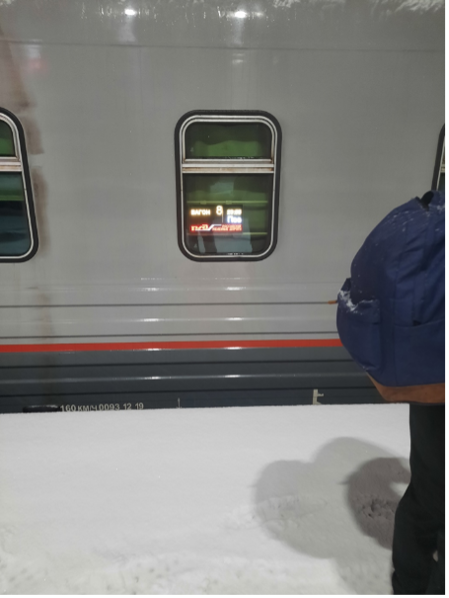
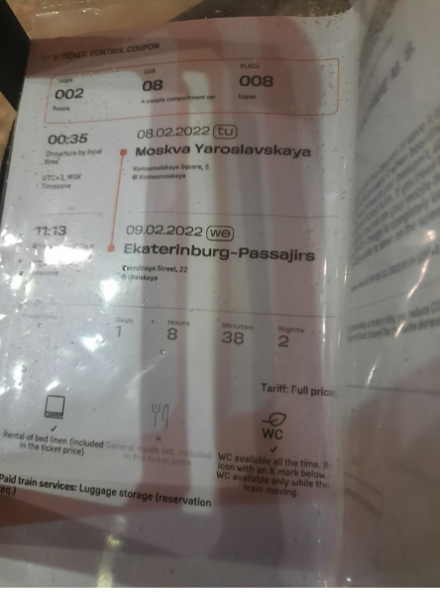
On seeing the train stop and the lights go on (with carriage attendants waiting by the doors), I walked past the restaurant car and was immediately a little disappointed at how unappealing it looked and decided that until I knew my way around, I would just stay in the cabin and see how things worked. Thankfully I had plenty of packets of soup and Welsh tea for sustenance as well as lots of bottled water
Each carriage has its own manager and assistant and prior to boarding (in the snow and temperature of around minus 15°C), I had to wait in turn to pass identity checks (this was worrying as I obviously had a UK passport and stood out from the others) but there was no problem and with a polite look at my passport , the carriage manager let me go on the carriage and then it was straight to my cabin (the travel agents had booked the same carriage number and cabin number to make things easy for myself, which was really appreciated).
The lights were off in the cabin and when I slid opened the door, was very disheartening on first glance. Dark, dismal and depressing which was made worse by the fact that the temperature in the train was +28°C and I had just come from Minus 15°C, sweating profusely, I fumbled for the light switch and threw my hat onto the table.
What had I let myself in for and the thought of a 2 night stay in the dismal cabin was not really exciting me? But I had no choice but to make the best of it and sort myself out and prepare for the journey to Yekaterinburg.
Each carriage has its own manager and assistant and prior to boarding (in the snow and temperature of around minus 15°C), I had to wait in turn to pass identity checks (this was worrying as I obviously had a UK passport and stood out from the others) but there was no problem and with a polite look at my passport , the carriage manager let me go on the carriage and then it was straight to my cabin (the travel agents had booked the same carriage number and cabin number to make things easy for myself, which was really appreciated).
The lights were off in the cabin and when I slid opened the door, was very disheartening on first glance. Dark, dismal and depressing which was made worse by the fact that the temperature in the train was +28°C and I had just come from Minus 15°C, sweating profusely, I fumbled for the light switch and threw my hat onto the table.
What had I let myself in for and the thought of a 2 night stay in the dismal cabin was not really exciting me? But I had no choice but to make the best of it and sort myself out and prepare for the journey to Yekaterinburg.
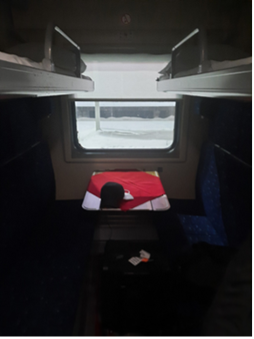
On looking around I started to have a better impression of the carriage and cabin. The corridor was spotless and the cabin appeared very clean and fresh with 4 beds and a small table by the window. Once the lights were on, things looked more positive and when the manager came round to the cabin, he put the two upper beds away (with their sheets, towels and covers strapped in which disappointed me as I was planning to spend time in each bed as I had paid for then. But life is full of disappointments), and suddenly the room looked more inviting.
Now I felt better, the cabin was not so bad and I felt that once I had a good night sleep, I would feel positive and more focussed on enjoying the adventure of the journey.
Now I felt better, the cabin was not so bad and I felt that once I had a good night sleep, I would feel positive and more focussed on enjoying the adventure of the journey.
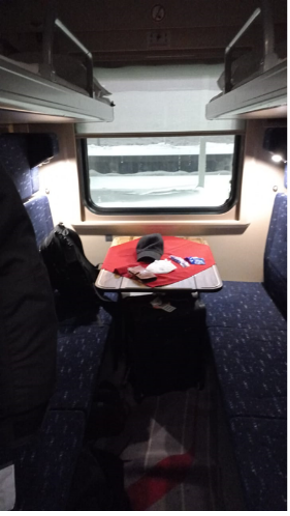
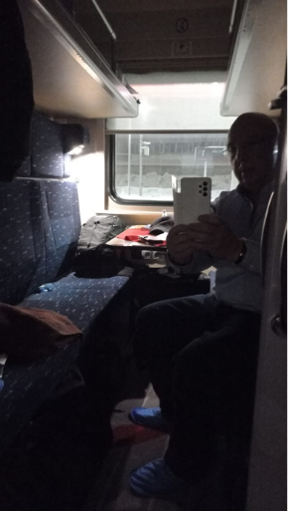
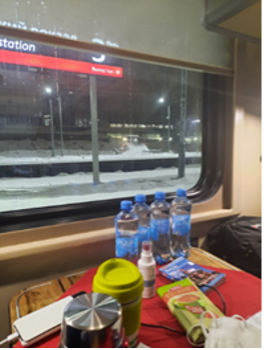
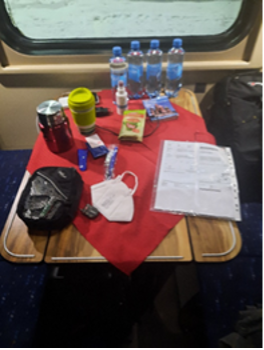
After putting the supplies on the table, bemoaning that I had decided not to take some more food and generally sorting out the bags and electric points, the train left the station and the journey started. I sat watching the train leaving Moscow and then went straight to bed which was folded down and ready made up to sleep. The carriage manager came round and quickly folded up the top bunk beds (finishing my plan to sleep in all 4 beds) but psychologically the cabin looked roomier and brighter. My mood was definitely improving.
What I was not aware of was that every 2 to 3 hours the train stopped for about 20-30 minutes for engine changes and also as it was the middle of winter at every station (large or small) wheel- tapper would work on the brakes and springs hitting ice build-up away. So, there was no chance for continuous sleep with the noise of the hammers hitting the gears below my cabin. It was not a peaceful sleep and I had to get used to the movement of the train and occasional sharp sudden movements as well as occasional stops at smaller stations. Some drivers were smoother than others which meant that there was a regular rhythm of the train for a few hours, break for up to 30 minutes and then another driver would have his own rhythm. I had no choice but to get used to this but tiredness and some nervous exhaustion definitely helped
Once up after the first night disturbed sleep I realised that looking out of the window, listening to music and reading my book was going to be the pattern for the next few days
I then had to get used to continuously moving scenery (how many trees, villages and frozen scenes can you look at?) and watching the countryside flying by. The door of the cabin had a large mirror on it, so that the cabin looked larger and gave the impression of a larger space. The luggage was under the seats and everything packed away easily. Now it was just a matter of getting used to a new regime of passing the day, reading. listening to music and watching the world go by.
Also, during the day, the carriage attendant came in every few hours to hoover the carpet and tidy the table and room generally. They also offered tea continuously. But no conversation at all. This was something that I had to appreciate, the solitude and quiet with no real interaction with people unless I went to the restaurant car and interacted with other passengers. Not really something that I really wanted to get involved in.
Once up after the first night disturbed sleep I realised that looking out of the window, listening to music and reading my book was going to be the pattern for the next few days
I then had to get used to continuously moving scenery (how many trees, villages and frozen scenes can you look at?) and watching the countryside flying by. The door of the cabin had a large mirror on it, so that the cabin looked larger and gave the impression of a larger space. The luggage was under the seats and everything packed away easily. Now it was just a matter of getting used to a new regime of passing the day, reading. listening to music and watching the world go by.
Also, during the day, the carriage attendant came in every few hours to hoover the carpet and tidy the table and room generally. They also offered tea continuously. But no conversation at all. This was something that I had to appreciate, the solitude and quiet with no real interaction with people unless I went to the restaurant car and interacted with other passengers. Not really something that I really wanted to get involved in.
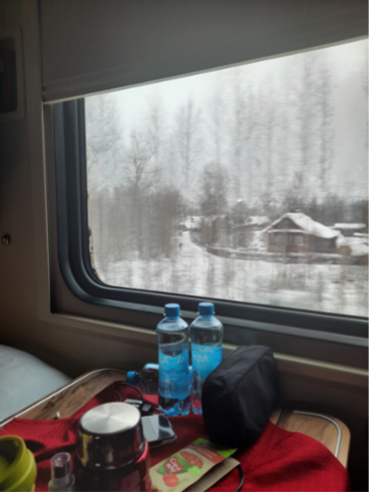
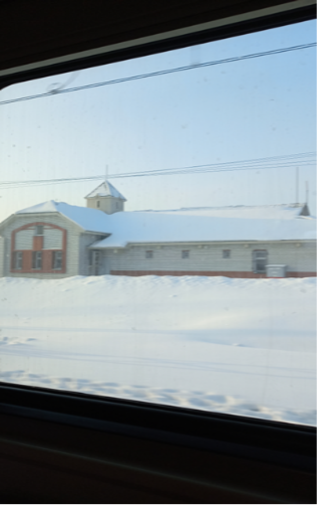
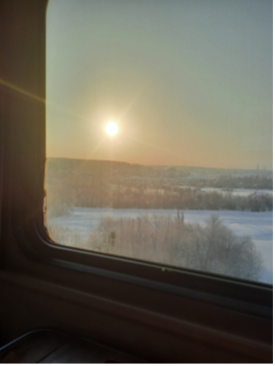
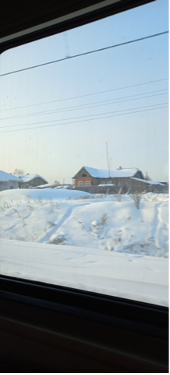
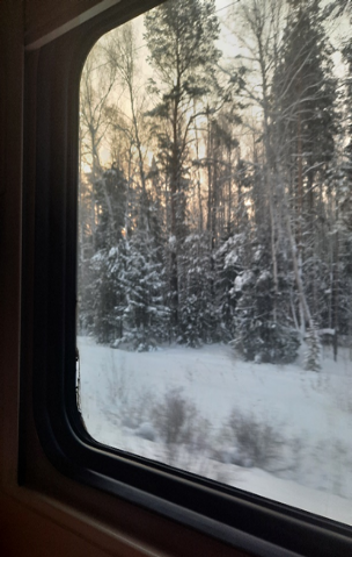
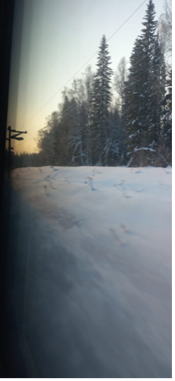
I soon got into a pattern and routine and tried to take the time in the cabin as a rest from the world and the need for interaction with people. This became very therapeutic and in fact I quite liked the silence and peace. We stopped some stations along the way, passed through towns, cities and small villages and gave me time to think about many things I had not had time to focus on over the years. The train was going to be “Michael Time “.
Thankfully I was not aware of talking to myself and in fact I found myself the calmest I had been for a long time. The isolation was also highlighted the fact that I had no access to news or family communication unless the train was in a station where there was a strong phone signal and Wi-Fi signal. Most of the time there was nothing.
Thankfully I was not aware of talking to myself and in fact I found myself the calmest I had been for a long time. The isolation was also highlighted the fact that I had no access to news or family communication unless the train was in a station where there was a strong phone signal and Wi-Fi signal. Most of the time there was nothing.
Yekaterinburg
9th February 2022
The train arrived on time in Yekaterinburg and I was ready for the first set of local tours. I was met by a fascinating and knowledgeable guide, Vadim and his wife Marina and the next few days had the most wonderful and informative set of tours in the company of two lovely and warm people. Vadim had his own tour company prior to Covid but had to close it due the collapse in the travel business and I was his first visitor since Covid. A well-known photographer and historian, I was really lucky to have had him take me on the tours and give me a wealth of information about Russian history in that region of Russia.
They made a big impression on me and I quickly relaxed in their company, although I became aware of not wanting to talk too much and when I did my voice was quiet and calm. I liked this new Michael.
Delivered to a comfortable hotel, a bath and bite to eat was the order of the day and dirty washing was put in the laundry bag ready for the following day. This was now my routine on arriving in a fresh hotel.
Yekaterinburg tours
10th February
This was the main tour day, very active with 4 tours rolled into one over a 12-hour period. a bit intensive but I was looking forward to a mixture of sightseeing, history and general information overload and I knew that it was going to be very intense and compact with lots of information along the way, but I was up for it, even though it was now minus 20°C and snowing most of the time.
The first part of the day was a trip around the city to get an over view as well as a visit to the Yeltsin Museum and other major sights. Yeltsin is still a well-respected person in Yekaterinburg as he originally was the governor there and the museum certainly highlights this clearly. His wife and family are now heading a number of charities and organisations in his name and memory.
The train arrived on time in Yekaterinburg and I was ready for the first set of local tours. I was met by a fascinating and knowledgeable guide, Vadim and his wife Marina and the next few days had the most wonderful and informative set of tours in the company of two lovely and warm people. Vadim had his own tour company prior to Covid but had to close it due the collapse in the travel business and I was his first visitor since Covid. A well-known photographer and historian, I was really lucky to have had him take me on the tours and give me a wealth of information about Russian history in that region of Russia.
They made a big impression on me and I quickly relaxed in their company, although I became aware of not wanting to talk too much and when I did my voice was quiet and calm. I liked this new Michael.
Delivered to a comfortable hotel, a bath and bite to eat was the order of the day and dirty washing was put in the laundry bag ready for the following day. This was now my routine on arriving in a fresh hotel.
Yekaterinburg tours
10th February
This was the main tour day, very active with 4 tours rolled into one over a 12-hour period. a bit intensive but I was looking forward to a mixture of sightseeing, history and general information overload and I knew that it was going to be very intense and compact with lots of information along the way, but I was up for it, even though it was now minus 20°C and snowing most of the time.
The first part of the day was a trip around the city to get an over view as well as a visit to the Yeltsin Museum and other major sights. Yeltsin is still a well-respected person in Yekaterinburg as he originally was the governor there and the museum certainly highlights this clearly. His wife and family are now heading a number of charities and organisations in his name and memory.
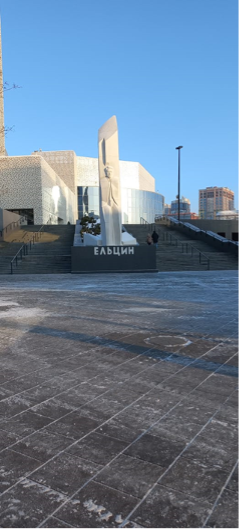
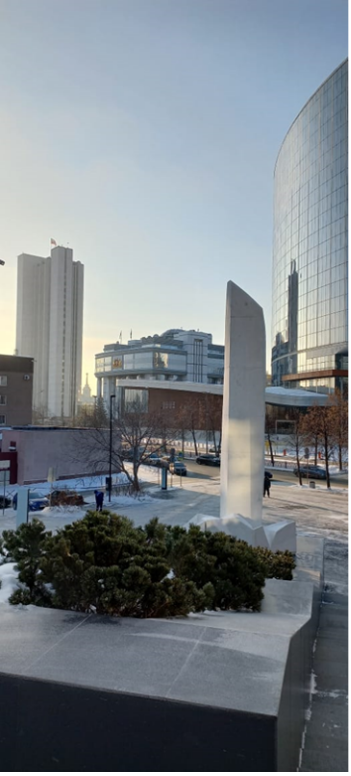
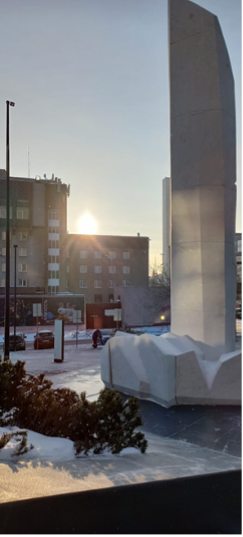
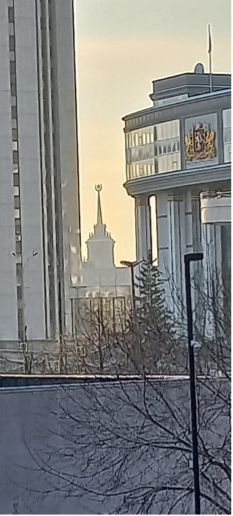
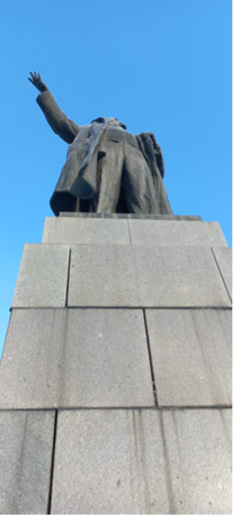
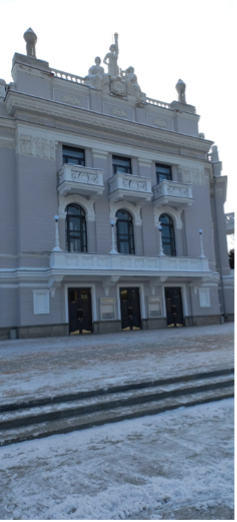
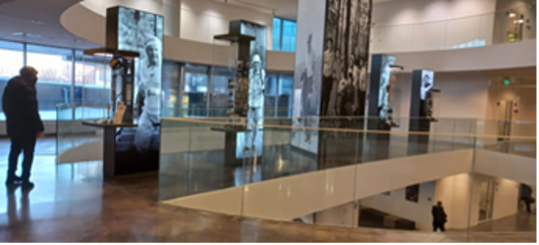
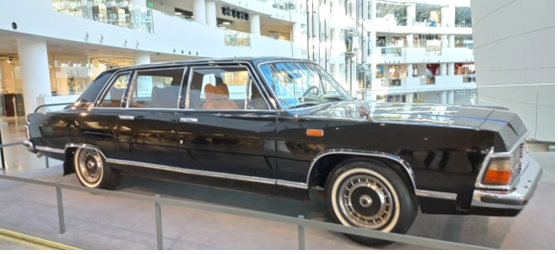
Whilst being housed in a very modern centre surrounded by brash modern buildings, the Yeltsin centre was not a common designed building and it was clear that the majority of buildings were pre-Soviet or post-soviet designs and structures as shown below.
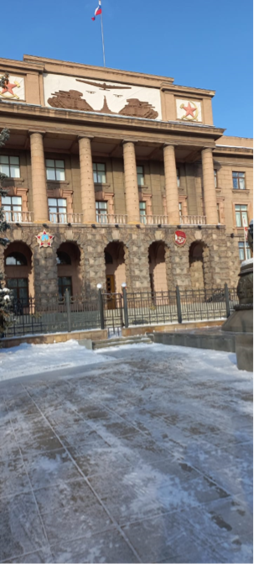
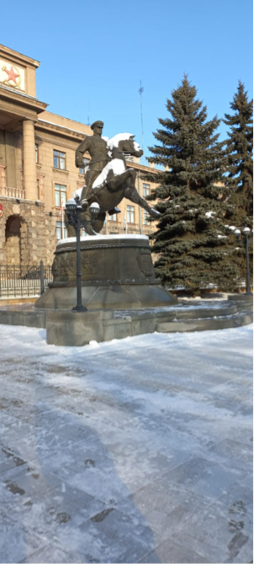
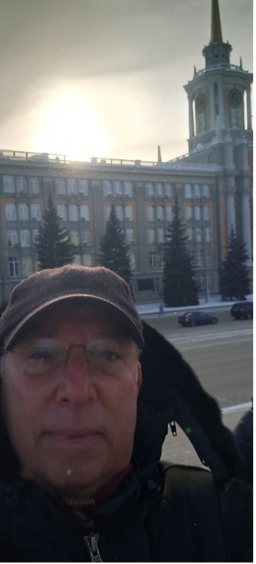
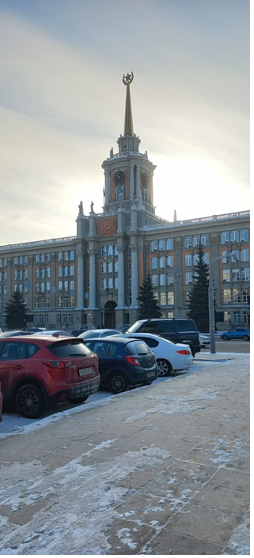
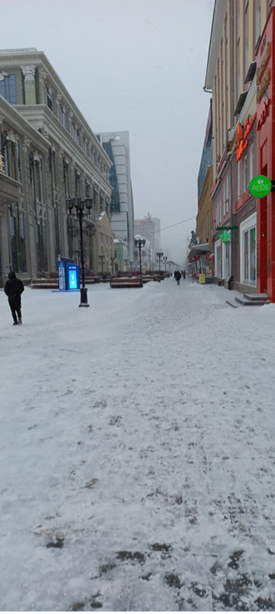
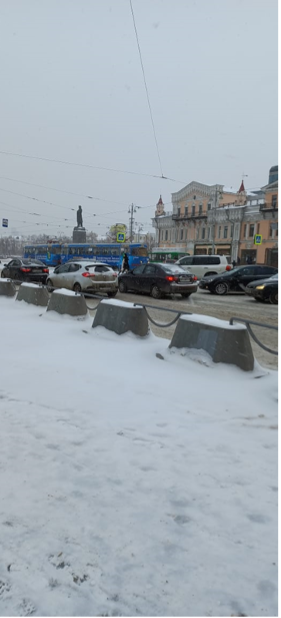
On the way to the border between European Russia and Asiatic Russia we passed a monument to victims of the Stalinist purges of the 1930’s where many educated and academic people and families simply disappeared and after torture and execution. Thousands are buried in the area of the memorials , many of them Jewish , most were denounced by neighbours and friends trying to save themselves .
Part of the awful history of this time in Russia and a very thought provoking memorial to the memories of those who disappeared and highlighted another period of turmoil and death under Stalin and was a theme repeated during the trip at various points. It also underlined that this city and region has a history of murder and death including the murder of the Romanov family which I would learn more about during the day . I found this whole history very unsettling and thought provoking. What would make citizens denounce their neighbours and relatives who were innocent of anything and then the perpetrators of the torture and killing live afterwards . “Following orders “ as a theme came to mind . it was just awful to consider and reflect upon and has had an impact on the way I view history and the current world situation.Something that I had never considered in the past bit definitely part of my views now.
Part of the awful history of this time in Russia and a very thought provoking memorial to the memories of those who disappeared and highlighted another period of turmoil and death under Stalin and was a theme repeated during the trip at various points. It also underlined that this city and region has a history of murder and death including the murder of the Romanov family which I would learn more about during the day . I found this whole history very unsettling and thought provoking. What would make citizens denounce their neighbours and relatives who were innocent of anything and then the perpetrators of the torture and killing live afterwards . “Following orders “ as a theme came to mind . it was just awful to consider and reflect upon and has had an impact on the way I view history and the current world situation.Something that I had never considered in the past bit definitely part of my views now.
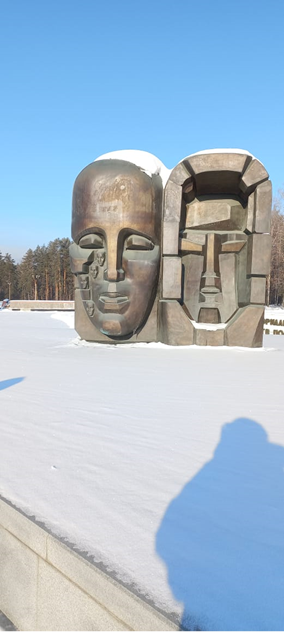
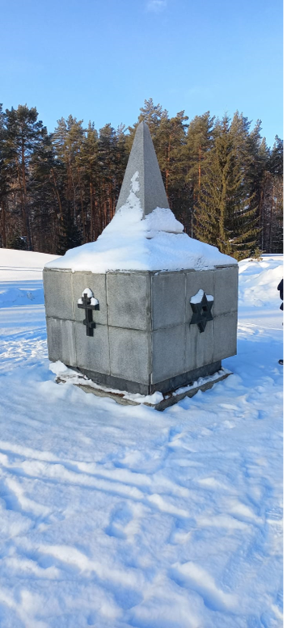
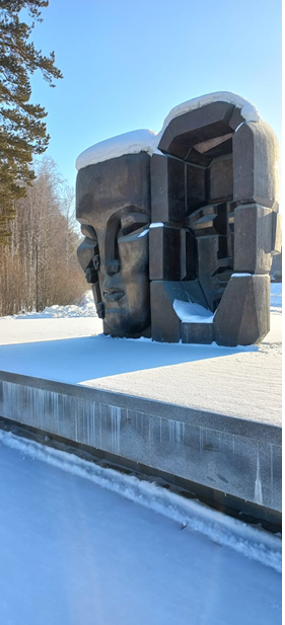
Next onto the Black Tulip memorial to Russian soldiers who fought and died Afghanistan in the 1980’s is very prominent in the city close to the various ministries of defence and government offices. The Black Tulip memorial is named after the nicknames of the flights repatriation the bodies of fallen soldiers. We often forget that Russia was there prior to ourselves and lost many men. It is a simple but solemn memorial and very touching
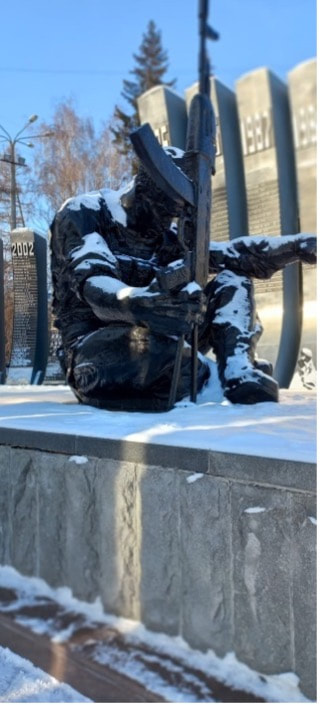
We then drove to the monument marking the border between Europe and Asia. It is really a small simple is marked by a simple monument on the main road to Moscow surrounded by forests. I was surprised about this monument’s simplicity and small size, not really what I was expecting but it was a place to visit and mark my journey with a certificate.
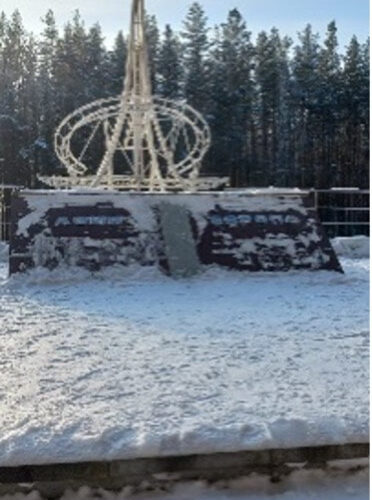
Unfortunately , Yekaterinburg is really the last scene in the story of the Romanovs dynasty and family. It is where they were taken to and executed and also the place where there has been great controversy regarding the exact location of the resting places of the family themselves.
Vadim and I visited a number of beautiful cathedrals, churches and buildings related to the Romanov history and last days and I have been left with a sense of grief for the family in the way that they were misled and murders and the way the daughters were tortured after being shot but not killed. How terrified they must have been in their last moments. Then to find that their remains were dumped and then secretly reburied only to be found decided later by dedicated researchers and workers is just so moving and sad. Now at least they rest in peace in St Petersburg all together with their servants.
I was also told about the man who led the execution team and how he boasted about his place in history and when he died his grave was covered with red blood paint and graffiti noting him as an evil man. Why has the world not learnt about this and why does this continue to happen? I do not understand the mentality and ignorance of people.” Following orders” and lack of humanity. Unless people learn the lessons, this sadness will continue again and again. This is one of the messages from my trip to Yekaterinburg.
Only in recent years, has the dedication of one man and his small team of investigators and historians found the bodies and got them identified by DNA analysis and they are all now reinterned in St Petersburg. The last remains that were found was of the young son and his carer whose bodies were burnt but were identified finally a few years ago.
The issue is that the Russian orthodox church decided that the final resting place of the family was in a wood near a disused copper mine shaft and subsequently consecrated the ground and built a number of churches on the spot as well as a small monetary and memorial. It was the wrong place and in 2022/2023 there will be a synod to accept the final resting place is in another location, which is simply marked by a small memorial placed there by the man and team that finally found the resting places.
Vadim and I visited a number of beautiful cathedrals, churches and buildings related to the Romanov history and last days and I have been left with a sense of grief for the family in the way that they were misled and murders and the way the daughters were tortured after being shot but not killed. How terrified they must have been in their last moments. Then to find that their remains were dumped and then secretly reburied only to be found decided later by dedicated researchers and workers is just so moving and sad. Now at least they rest in peace in St Petersburg all together with their servants.
I was also told about the man who led the execution team and how he boasted about his place in history and when he died his grave was covered with red blood paint and graffiti noting him as an evil man. Why has the world not learnt about this and why does this continue to happen? I do not understand the mentality and ignorance of people.” Following orders” and lack of humanity. Unless people learn the lessons, this sadness will continue again and again. This is one of the messages from my trip to Yekaterinburg.
Only in recent years, has the dedication of one man and his small team of investigators and historians found the bodies and got them identified by DNA analysis and they are all now reinterned in St Petersburg. The last remains that were found was of the young son and his carer whose bodies were burnt but were identified finally a few years ago.
The issue is that the Russian orthodox church decided that the final resting place of the family was in a wood near a disused copper mine shaft and subsequently consecrated the ground and built a number of churches on the spot as well as a small monetary and memorial. It was the wrong place and in 2022/2023 there will be a synod to accept the final resting place is in another location, which is simply marked by a small memorial placed there by the man and team that finally found the resting places.
A sad story that still needs completion and finalisation and Russia needs to come to terms finally with the effects of history on actions.
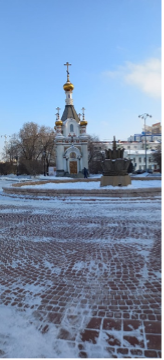
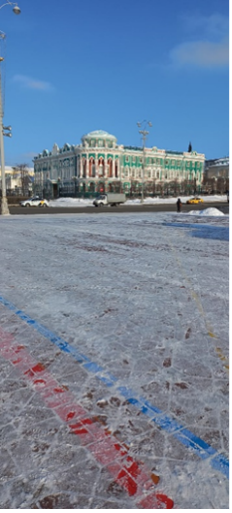
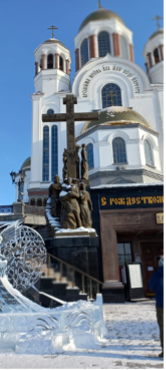
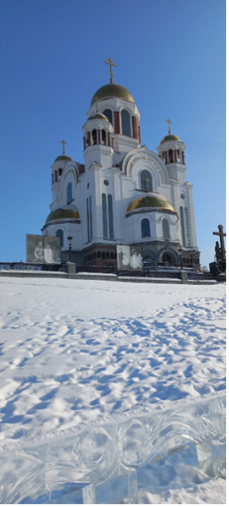
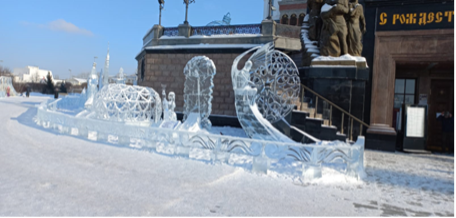
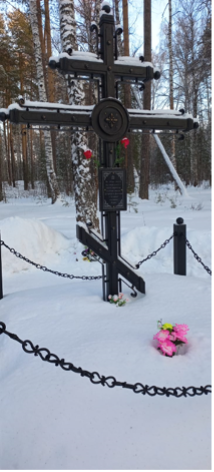
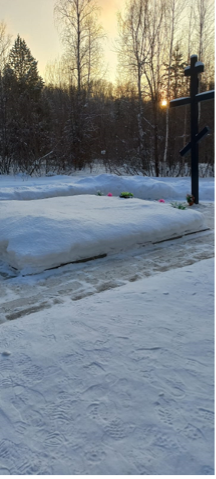
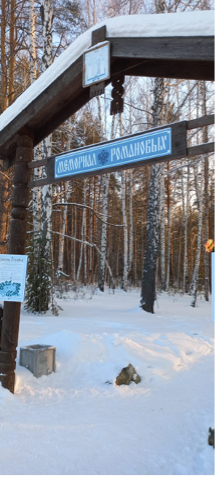
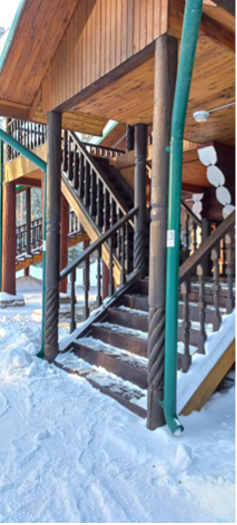
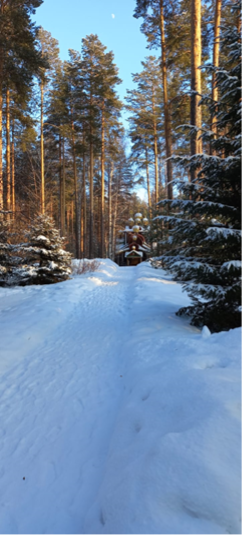
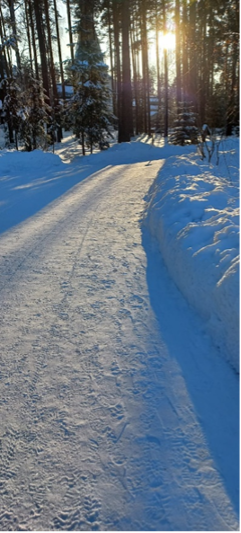
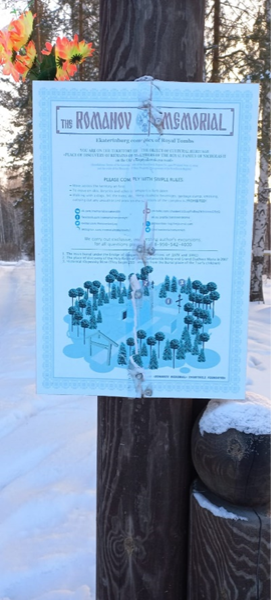
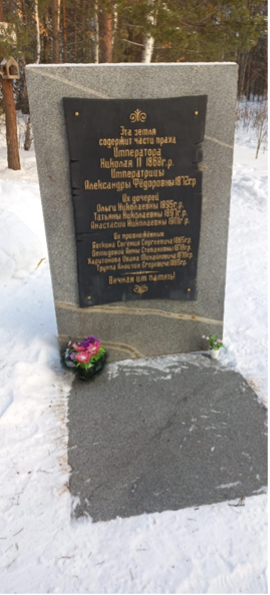
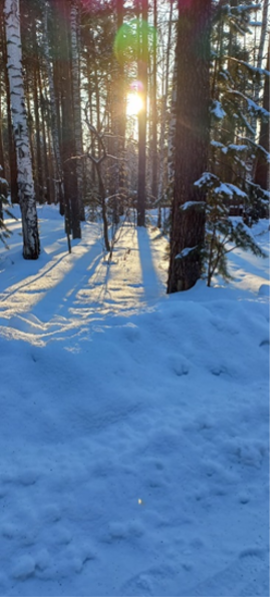
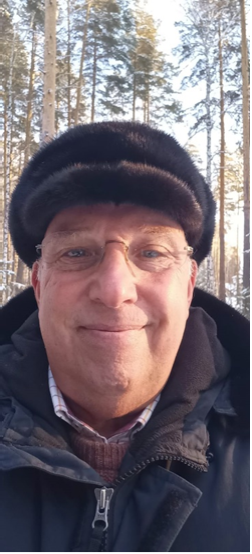
Another lesser-known fact is that in 1960, Yekaterinburg was the city where the USAF U2 reconnaissance plane was shot down and the pilot, Francis Gary Powers captured and there are monuments in the city marking this.
The day was very intense and also the amount of information that I was given was really significant. I could have done with a recording, but it was my first side trip and I was grateful to Vadim and Marina for everything that they did not me and the friendship they showed me during the time that we were together.
The day was very intense and also the amount of information that I was given was really significant. I could have done with a recording, but it was my first side trip and I was grateful to Vadim and Marina for everything that they did not me and the friendship they showed me during the time that we were together.
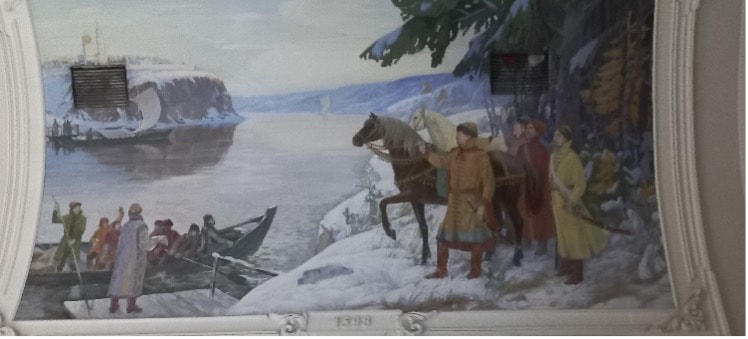
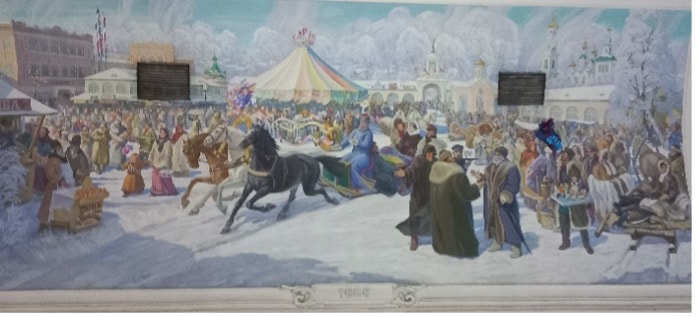
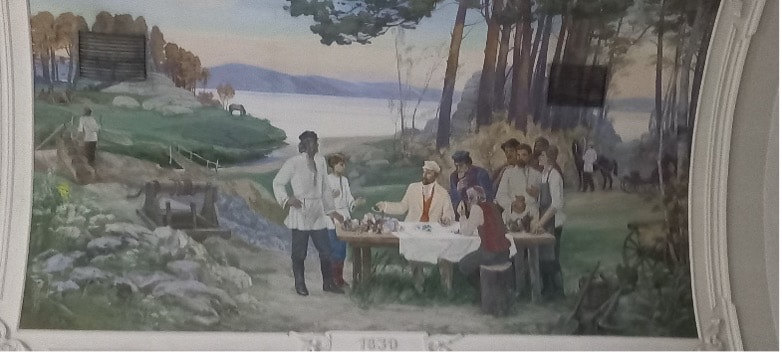
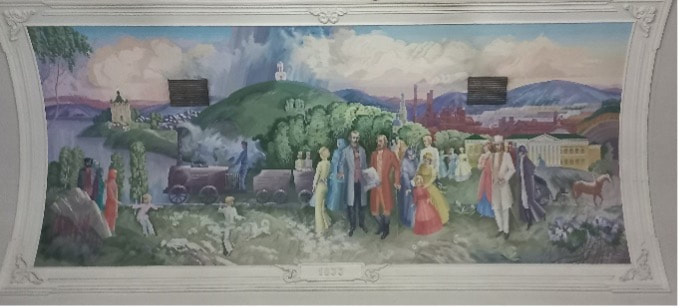
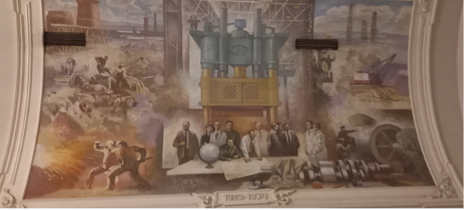
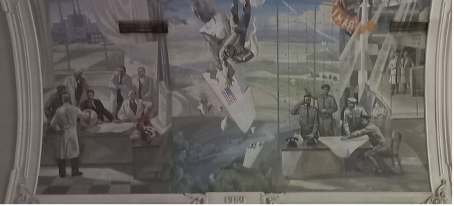
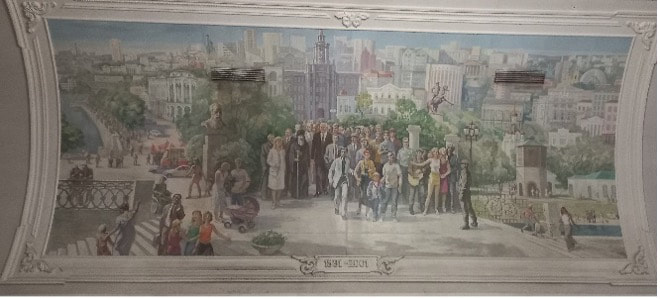
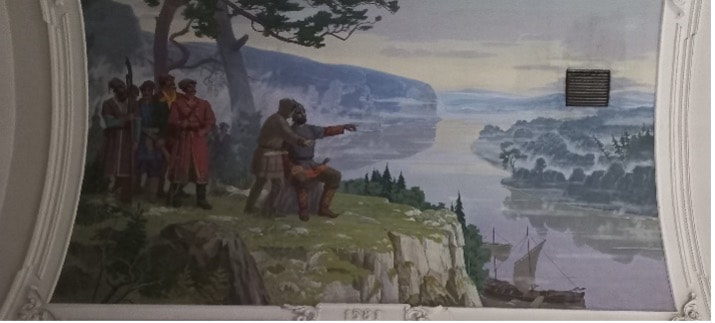
Train to Irkutsk
12th February 2022 at 03.43
Marina and Vadim picked me up at 02.30 am in the morning and as well as taking me to the station, Vadim showed me some paintings in the station telling the history of Yekaterinburg that people do not often see, it was a great end to my time in the city and in their company. Marina also gave me some supplies for the train trip which were really appreciated and them Vadim took me to the carriage and made certain that all was ok and that I was settled down ready for the next stage of the journey. I felt at home in the train, knowing the procedures and spaces as well as where the toilet was (very important). I was now going on the 62 train and the cabin was slightly different to the 002 train, a little older but still perfectly clean.
So, a couple of days ahead of me until Irkutsk and a lot more bumps along the way but this time the ticket came with one meal a day, so I could stop drinking 3-4 cups of soup per day interspersed with tea. Either fish or meat, no real choice which also came with a salad and some fruit for afterwards and various free juices as well. heaven….Time passed and scenery changed and sunrises and sunsets were wonderful. I was lucky with the weather no blizzards to spoil the views. It was getting colder and more extreme but I was safe in the cabin in 28°C and now being fed at least one meal a day supplemented by my packet soups. I became addicted to Telma pea soup in particular …
Marina and Vadim picked me up at 02.30 am in the morning and as well as taking me to the station, Vadim showed me some paintings in the station telling the history of Yekaterinburg that people do not often see, it was a great end to my time in the city and in their company. Marina also gave me some supplies for the train trip which were really appreciated and them Vadim took me to the carriage and made certain that all was ok and that I was settled down ready for the next stage of the journey. I felt at home in the train, knowing the procedures and spaces as well as where the toilet was (very important). I was now going on the 62 train and the cabin was slightly different to the 002 train, a little older but still perfectly clean.
So, a couple of days ahead of me until Irkutsk and a lot more bumps along the way but this time the ticket came with one meal a day, so I could stop drinking 3-4 cups of soup per day interspersed with tea. Either fish or meat, no real choice which also came with a salad and some fruit for afterwards and various free juices as well. heaven….Time passed and scenery changed and sunrises and sunsets were wonderful. I was lucky with the weather no blizzards to spoil the views. It was getting colder and more extreme but I was safe in the cabin in 28°C and now being fed at least one meal a day supplemented by my packet soups. I became addicted to Telma pea soup in particular …
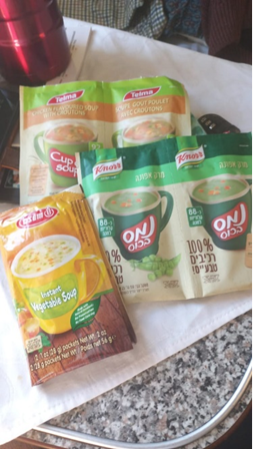
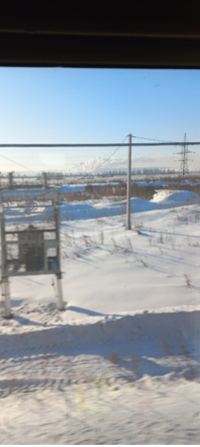
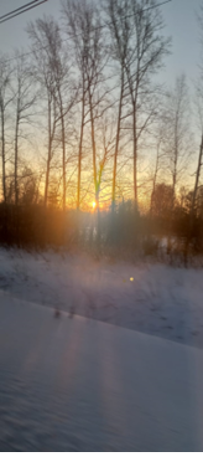
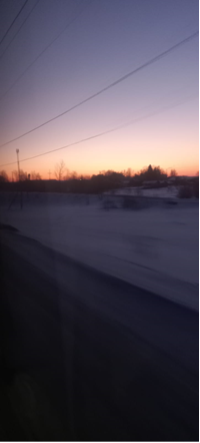
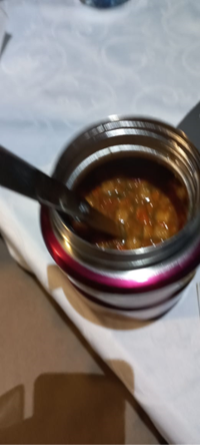
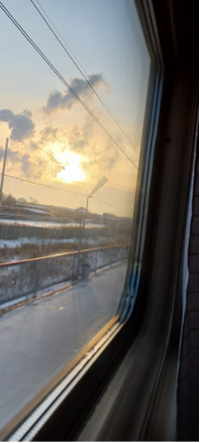
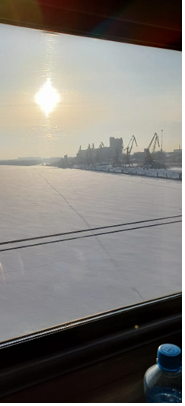
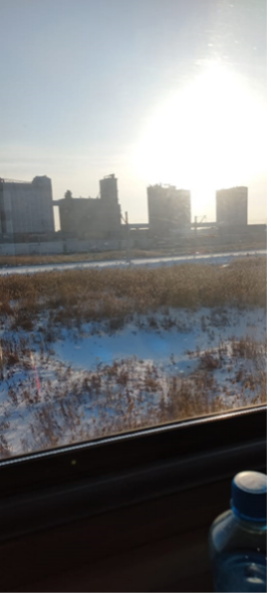
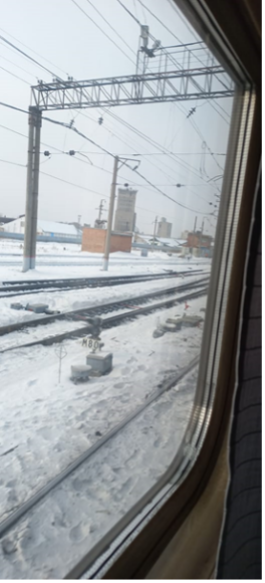
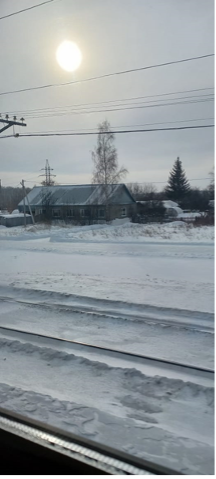
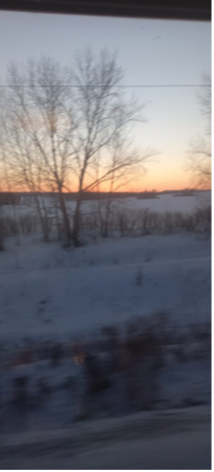
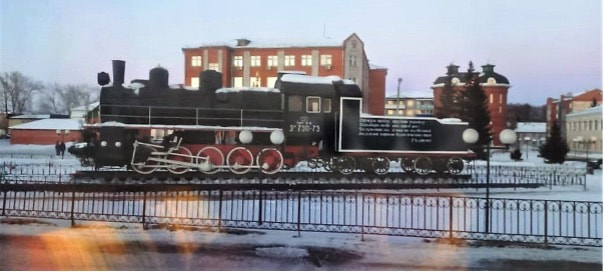
I was in a routine now and became quite institutionalised in some senses. I found my mind drifting during the day and at night my dreams became more vivid and appeared to me to be very real.
Strangely, as I was drifting in and out of sleep on this stage of the journey , my father and very close friends came to me and we had conversations and I felt close to them and very comforted. It was a surreal experience but very comfortable. We spoke about many things and it was as if they were listening and advising at the same time.
I felt very reassured and rested after these visits which happened during this particular stage of the journey. I am not certain what caused them to occur (I had not been drinking or even eating to excess) but I remember most of the chats quite clearly now.
I even felt they were sitting on the bed next to me, just talking and listening.
Was I hallucinating or was this my isolation bringing needs and emotions to the fore?
I really do not know but I am certain they left me comforted and rested as well. Worries seemed to drifted away. It was another experience that I had never expected and anticipated on this trip.
Has this happened since my return? No.
Strangely, as I was drifting in and out of sleep on this stage of the journey , my father and very close friends came to me and we had conversations and I felt close to them and very comforted. It was a surreal experience but very comfortable. We spoke about many things and it was as if they were listening and advising at the same time.
I felt very reassured and rested after these visits which happened during this particular stage of the journey. I am not certain what caused them to occur (I had not been drinking or even eating to excess) but I remember most of the chats quite clearly now.
I even felt they were sitting on the bed next to me, just talking and listening.
Was I hallucinating or was this my isolation bringing needs and emotions to the fore?
I really do not know but I am certain they left me comforted and rested as well. Worries seemed to drifted away. It was another experience that I had never expected and anticipated on this trip.
Has this happened since my return? No.
